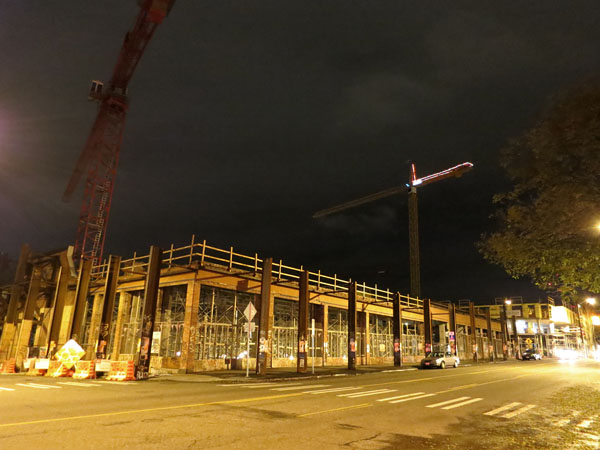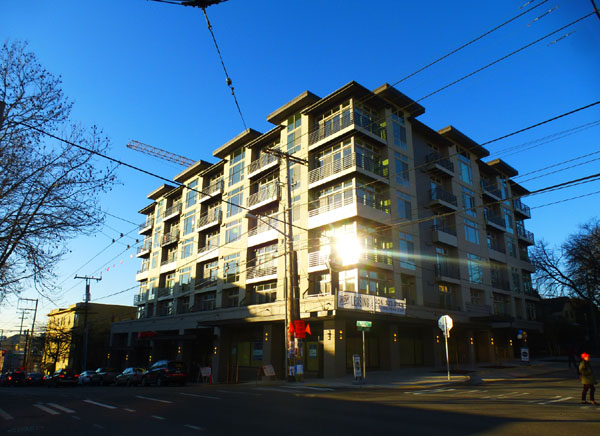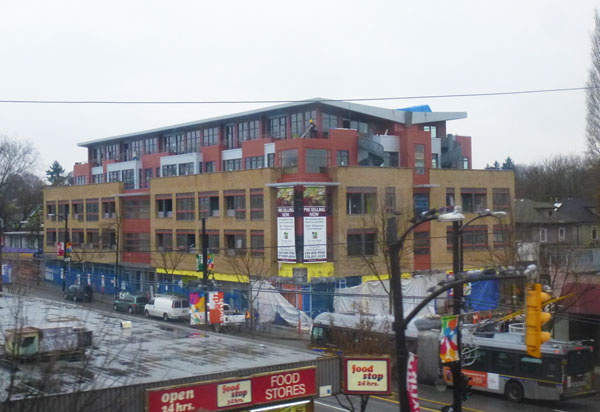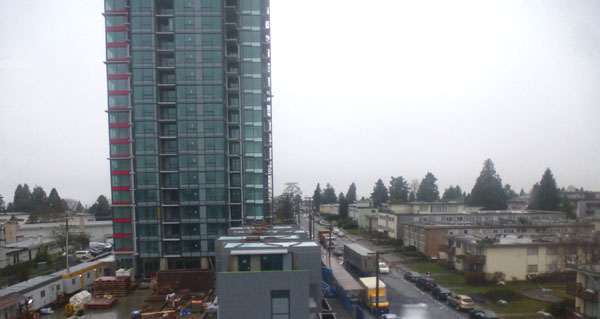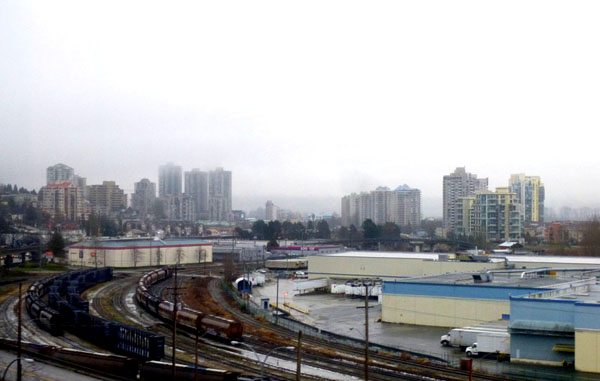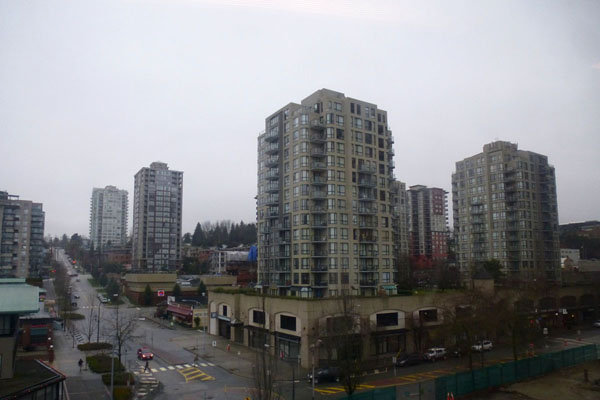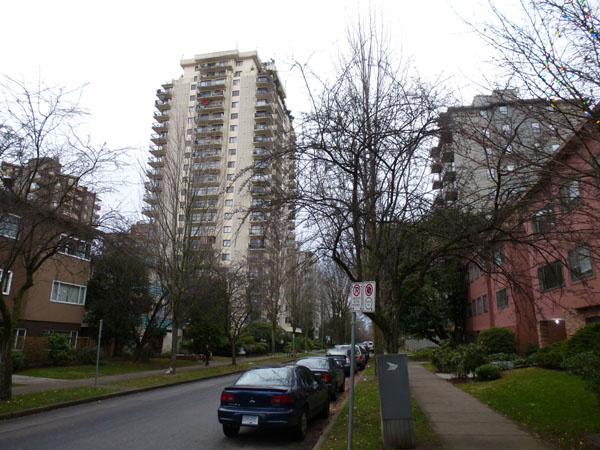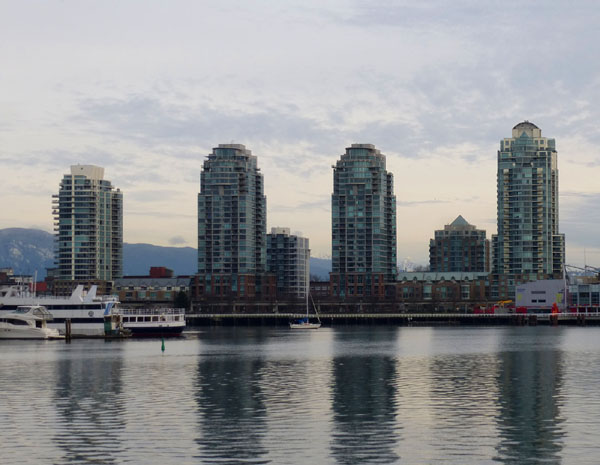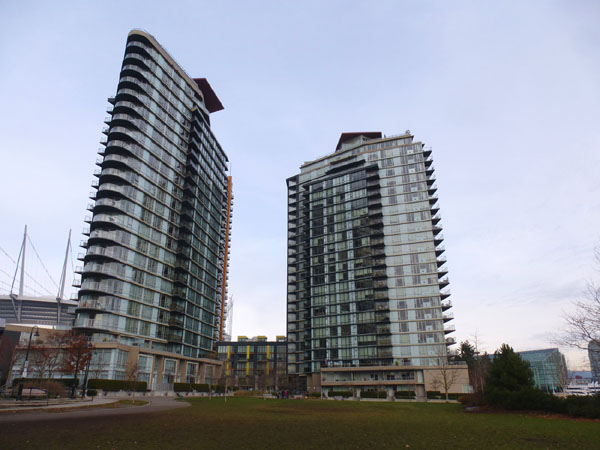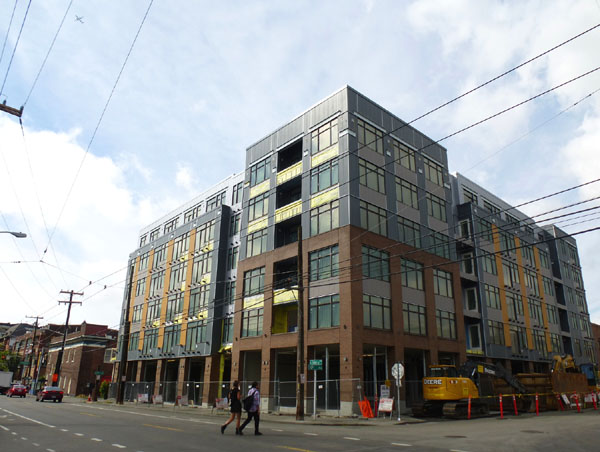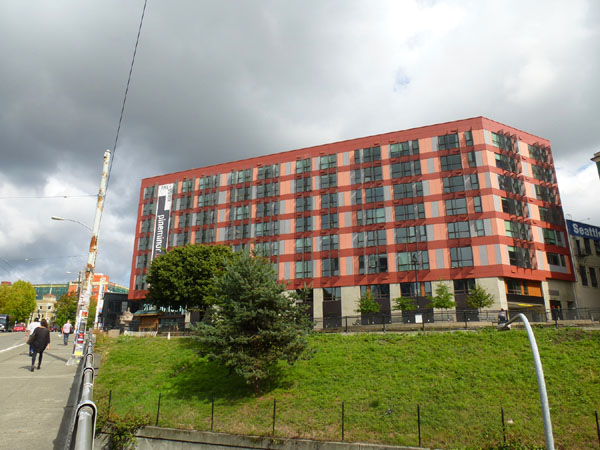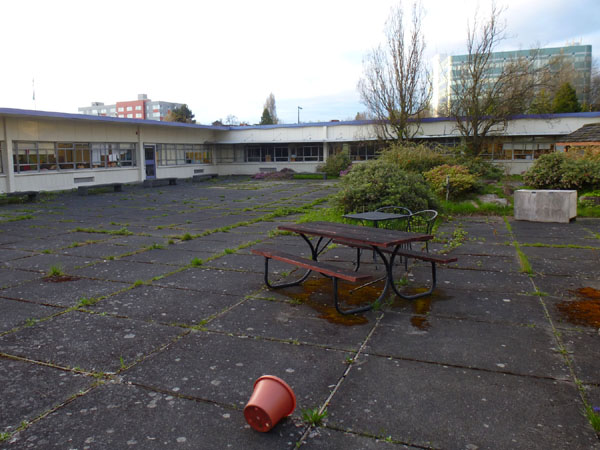Linkage Fees Will Impede Housing Production
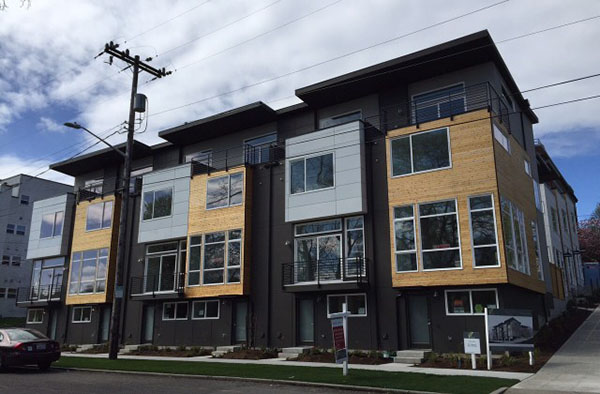
At the heart of the debate over Seattle’s proposed linkage fee is the question of whether it undermines its own intent to provide affordable housing by either raising rents or impeding the production of housing. A recent post by Owen Pickford at The Urbanist argues that a linkage fee would have no negative impact on the housing market, and therefore “urbanists must support it.” This post will explain why that position has no merit.
Other than cases of unique developments that have limited substitutes, a linkage fee will result in a reduction in land values rather than increased rents. So what we need to examine is the effect of depressed land values on the production of housing.
The most widely used metric for predicting whether a piece of property can be redeveloped is the ratio of the value of the improvements on the land, to the value of the land itself. The larger the ratio, the less likely a property will redevelop. Right away we can see that because a linkage fee reduces land value but not improvement value, it skews that ratio towards predicting no redevelopment.
To put a finer point on it:Â Pickford’s position contradicts the standard methodology used by the City of Seattle, King County and countless other municipalities to estimate “buildable land,” that is, land that can be redeveloped. This alone should be enough to cast serious doubt.
Overall, on my assessment Pickford’s argument that a linkage fee would not impede housing production is flawed for two primary reasons: It neglects the role of the property seller and existing uses; and it relies on supporting evidence that is highly tenuous, if not irrelevant.
The Role of the Seller and Existing Uses
Housing production in Seattle almost always involves redevelopment of property that has income-generating existing uses on it. The typical owner of a property that is being considered for redevelopment will evaluate an offer from a buyer based on the net present value of the property (i.e. including income from existing uses), compared to what the cash from the sale could earn if it was put into other investments. Add a linkage fee to this equation and the buyer’s cash offer will be lower, tipping the scales towards holding on to the existing income-generating use—that is, not selling. And not selling means no new housing.
A linkage fee’s level of impact on these hold/sell decisions will depend on the value of the existing uses relative to the land. And where it will have the greatest tendency to hinder sales for redevelopment is in areas with lower land values where feasibility is currently marginal, such as the Rainier Valley, Northgate, and the International District—in other words, the very locations where the City most needs new housing to meet its goals for sustainable development.
Furthermore, most larger-scale housing developments require the assembly of parcels with multiple owners. The reduced likelihood of a sale caused by a linkage fee will be compounded by every individual sale that’s necessary—and it only takes one refusal to kill the whole deal. Anyone with experience in development knows that land acquisition and assembly is one of the most challenging steps in the process.
Sellers can be motivated by numerous reasons, but one scenario that’s easy to understand is the owner who wants to sell out and retire: the higher the price, the sooner they can retire. Slap on a million dollar linkage fee, and maybe they’ll wait it out through the next development cycle—perhaps 7 years or more—until market rents rise enough to offset that million dollar hit to their nest egg caused by the linkage fee.
The relationship between land values and redevelopment can be readily observed in neighborhoods all over Seattle where the market has become hot. As localized demand for housing increases and market rents rise, developers can pay more for land. And that’s when you start to see an uptick in property transactions for redevelopment—it’s the reason there are too many cranes to count in Pike/Pine, but none in Rainier Beach.
Given that every development project is unique, and given how the market varies over both geography and time, it’s delusional to believe that the City could set a linkage fee rate in some kind of “sweet spot” that wouldn’t end up sabotaging land transactions for redevelopment. Pickford asserts that a linkage fee could actually increase housing supply by directing more funds to housing production, but the risk is that each typical midrise housing project made infeasible by a linkage fee will mean another couple hundred people competing for existing housing and pushing the poor out of Seattle. And for each project rendered infeasible, it would take roughly 25 feasible projects to create the number of affordable units equivalent to the market units not built due to the linkage fee.
Lastly, for cases in which the developer already owns the land, it is even more clear why a linkage fee would impede redevelopment. The decision to invest in redevelopment will be based on the risk versus the return, and the linkage fee will reduce the return. It’s really that simple. Even property owners with deep pockets can opt to do other things with their money if redevelopment becomes a less attractive investment. They can just wait it out until rents rise enough to offset the loss of returns caused by the linkage fee.
Debunking the Evidence
The first piece of evidence Pickford presents to make the case that the factors I describe above would not impede housing development is historical data showing that the number of homes and condos for sale in Seattle is not influenced by average sales price—that is, people aren’t more inclined to sell their homes when prices are high, and vice-versa. However, most people who are selling homes live in them, and therefore most will be purchasing (or renting) another home in the same housing market with the same price trends. Therefore it makes all the sense in the world that sales price wouldn’t effect sales volume—for homes.
In contrast, sales that lead to high-density housing development are most often commercial properties, and the owners are typically investors who have the option to put proceeds from a property sale into other investments that don’t follow the price trends of the housing market. For example, the hit in property value caused by a linkage fee might mean the seller could only buy 800 shares of stock instead of 1000 with the cash from the sale, such that keeping the property makes more financial sense. The upshot is that data on home sales tell us very little about the property transactions that matter most for housing production, and thus are not credible evidence to support Pickford’s argument.
The second type of supporting evidence provided by Pickford is national studies showing that Inclusionary Zoning (IZ) has had no effect on the production of housing. Most of these studies look at cities in California where IZ is common. But a critical difference between a linkage fee and the IZ programs in California is actually emphasized in one of the papers cited by Pickford:
“It is worth reiterating that the programs we analyzed offer housing developers numerous cost-offsets, in accordance with California’s Density Bonus Law, to help make the inclusionary requirement revenue-neutral.”
If an IZ program is “revenue neutral†it means that it would not cause any reduction of land value, and therefore no impacts on housing production would be expected! In contrast, Seattle’s proposed linkage fee offers zero in the way of cost-offsets. Thus the results of all of the California IZ studies should be presumed to have no relevance to linkage fees.
Another shortcoming of the IZ studies cited by Pickford is their focus on single-family houses. For one thing, Seattle’s proposed linkage fee wouldn’t even apply to single-family, but more importantly, suburban single-family home development tends to involve land transactions that differ significantly from those involved in high density urban infill. In any case, perhaps not surprisingly, the one cited analysis for single-family homes outside of California (suburban Boston, where minor cost-offsets are typical) found “some evidence that IZ has constrained production and increased the prices of single-family houses.â€
Pickford also highlights a result in one of the studies that multifamily production increased after IZ was imposed, yet neglects to mention that the reason this happened was that production shifted from single-family to multifamily—a process that could not possibly happen in the case of Seattle. This same study found that single family house prices increased under IZ, which, of course, is the expected effect of a linkage fee if it doesn’t push land values down.
Ironically, evidence that a linkage fee would impede housing production is inadvertently provided by one of the papers cited by Pickford:
“The passage of the 1986 Tax Reform Act is associated with a sharp drop in new housing production. The act ended favorable tax treatment of market-rate rental housing, which effectively subsidized that housing. In almost all jurisdictions surveyed, housing production figures dropped significantly after 1986.”
In terms of the impact on land values, eliminating a tax subsidy for multifamily is effectively the same thing as imposing a linkage fee. So it’s completely reasonable to expect the result of a linkage fee to be the same: significantly less housing produced.
Lastly, Pickford’s citation of two impact fee studies as evidence is even more tenuous than the IZ studies, because the effects are attributed to other factors, as the authors explain:
“The finding that land values fall, despite the fact that the increase in new home prices exceeds the total value of the fees, can be attributed to developer uncertainty regarding future increases in fees.”
“Our theoretical model shows that impact fees may expand housing construction within suburban areas by reducing exclusionary regulations and increasing the percentage of proposed projects receiving local government approval.”
Housing Supply and the Precautionary Principle
In assessing the potential impact of a linkage fee, it is important to remember that the root cause of Seattle’s housing affordability crunch is that housing production has not kept up with demand. Therefore, any proposed policy such as a linkage fee ought to be highly scrutinized to ensure that it won’t hinder the development of new housing.
Given the well-founded reasons a linkage fee can be expected to impede housing production (see above), the burden of proof falls on those who support the fee to prove that it would do no harm—a.k.a. the precautionary principle. By this measure, Owen Pickford’s attempt is clearly a failure, and reads more like a predetermined answer grasping for straws of evidence. And not only does Pickford’s argument lack evidence, it ignores fundamental human nature: In what universe does the option of getting more cash sooner for an asset not incent an investor to sell, and vice-versa?
It would be great if the linkage fee was a “free lunch” solution to fund affordable housing, but as is always the case in the real world, there is no free lunch. And what’s even worse with a linkage fee is that it’s greatest negative impact on housing production will occur precisely in the locations where redevelopment economics are already marginal—the very places where Seattle needs new housing most. There are better solutions to address affordable housing in Seattle, and that is where urbanists should be focusing their effort.
>>>
Dan Bertolet is an urban planner with VIA Architecture, a firm that consults to clients who could be impacted by a linkage fee. This post was originally published at Smart Growth Seattle, and has been edited for clarity and emphasis.
Why New Market Housing Reduces Displacement
Most Seattleites understand that the public has an obligation to subsidize housing for the city’s most needy, and residents have voted twice to tax themselves to that end through the housing levy. What’s far less appreciated is the essential role of the private sector in sustaining affordable housing.
It’s probably safe to say that the average Seattleite-on-the-street believes that expensive new housing is a major cause of declining affordability. And that is a regrettable thing. Because under current conditions of high demand for housing in Seattle, the reality is that new housing—regardless of price—actually abates displacement of those on the lower end of the income spectrum.
How can this be?
Consider the simplified case of a city with a total of five rentals ranging from cheap to expensive, and five people living in them with corresponding incomes. Along comes a wealthy newcomer who offers more for the most expensive unit, so the landlord raises the rent and the newcomer gets the unit because the current tenant can’t afford to pay that much.
The person who was displaced then offers more for the next cheapest rental, and so that landlord raises the rent, displacing the current tenant, who then bids up the next cheapest rental, and so on. In the end the person left without a place to live is the one with the lowest income of the five original renters.
Now consider how that scenario changes dramatically when there is one simple difference: a newly built expensive rental is available. The wealthy newcomer rents that unit, and that’s it—nothing changes for any of the existing five renters. No rents are raised, and no one is displaced. As counterintuitive as it may seem, the creation of a new expensive rental prevented displacement of the poorest renter.
Today in Seattle, the scenario of the lacking new unit is the fundamental process behind declining affordability and increasing displacement. And that’s why the ever popular sport of bashing “greedy developers” for building “luxury” housing is actually doing more harm than good.
Yes, of course Seattle’s housing system is far more complex than the above thought experiment. But none of those complexities negates the fact that the root problem is we’re not making enough room for newcomers. Still, this idea tends to encounter remarkably spirited resistance in progressive circles. Here are five common objections and why they are misguided:
- New housing causes displacement because older, cheaper housing is demolished to make way for it.
In recent years the ratio of new to demolished housing in Seattle has been about eight to one, which means that displacement prevented by new housing far outweighs any displacement caused. For high density housing the ratio is more likely in the range of 50 or 100 to one. That’s because a lot of new high density housing is built on parking lots or spent commercial buildings, as is readily observed in the city’s growing neighborhoods such Capitol Hill, Ballard, or downtown.
- New expensive housing drives up rents of surrounding housing; owners of new housing keep their units vacant to drive up rents; outside investors are buying up housing in Seattle and jacking rents to cover the inflated prices they pay.
The simple reason all of these related claims have no merit is because the primary determinant of rents is demand. And neither the existence of expensive housing, nor vacant units, nor inflated rents can create demand. These factors may introduce short-term marginal upticks, but over the long-term, rents always fall back in line with demand. This is simply indisputable reality, as verified by decades real estate market data.
- Housing consists of multiple bifurcated markets, so new expensive apartments do not affect prices of any other type of housing.
Regarding price, the thought experiment discussed above illustrates that in a large housing market there is a continuum of prices that allows renters to easily move up and down the market as needed—in other words, there is no financial bifurcation. Regarding housing type, bifurcation can be a factor, but the fact is, every new apartment added to the stock absorbs demand from a household that otherwise may have been forced to compete for other options. For example, a person who can’t find a cheap enough apartment may end up renting a room in a shared single-family house. Ultimately, every unit built relieves the entire market.
- The market cannot provide affordable housing.
It is no secret that the raw costs of production are simply too high for new housing to be affordable to a significant swath of the lower end of the income spectrum. But to claim that the market doesn’t provide affordable housing is highly disingenuous. Past census data and market surveys show that about three quarters of Seattle’s rentals were affordable to households earning 80 percent of the area median income. Today’s new housing becomes tomorrow’s affordable housing as it ages. Furthermore, because new housing absorbs demand, it reduces market pressure to renovate older, cheaper housing, thereby helping to preserve these low-rent options and reducing displacement.
- It’s a lost cause because we can’t build fast enough to get ahead of demand.
Even if production isn’t keeping up with demand, each new unit still has the potential to prevent one poor household from being displaced. It’s far from a lost cause to the person who can afford to stay in his or her home because just one additional unit of housing was built. This is not to say that building new housing will solve the whole problem. Subsidies will always be necessary to provide decent housing for the poorest households, as has been true in cities for centuries. But when so many people want to live here, the less new housing we build, the bigger the subsidy problem becomes.
>>>
If Seattle hopes to successfully tackle affordability, the critical role of market housing must be given more weight in policymaking. Take for example Capitol Hill, one of the city’s most in-demand neighborhoods, for which a policy choice has been made to not allow high-rise buildings, a policy that will curtail the creation of new housing by hundreds, if not thousands of units. And that translates to hundreds if not thousands more lower-income residents displaced from the neighborhood. Limiting height or density in places where there is strong demand is putting aesthetics before social equity.
In the public conversation about housing affordability in Seattle, rigid progressive ideology all too often leads to the demonization of private developers. But this can only lead to failure, because it will encourage policies that attempt to solve the problem at the expense of market production, such as the City’s proposed linkage fee.
Again, to be clear, no one is saying that market production alone will solve Seattle’s affordability problem.
There will always be some level of subsidy necessary, but that level will be determined by the balance of supply and demand. If market production continues to fall behind demand, the need for subsidy will balloon to the point where it becomes essentially unsolvable, as it has in San Francisco. And even if some households are protected from displacement through subsidized housing, the displacement caused by housing scarcity will simply shift to the next poorest households not protected.
It’s really not that complicated. Seattle has a housing shortage. Every occupied new unit of higher cost housing translates to one less higher income household competing for a limited amount of existing housing. And whenever there are more people who want housing than there are housing units, it will be the poorest who lose.
>>>
This post originally appeared on PubliCola.
We Already Have The Tools To Meet Seattle’s Need For Affordable Housing
Concerns over rising housing prices in Seattle have once again provoked heated public debate over what to do about it. In response, City Council’s proposed solution for funding subsidized affordable housing is a so-called linkage fee—a extra tax on all new development based on the amount that’s built. As I have argued previously, the linkage fee has serious shortcomings and is likely to exacerbate the very problem it is intended to address by either increasing the cost of new housing, or slowing its production.
What most Seattle policymakers appear to be overlooking is that Seattle’s projected affordable housing needs could be met by simply strengthening existing, proven programs, without resorting to an untried, complicated linkage fee that is both unfair and counterproductive. The true solutions staring us all in the face are the Housing Levy and the Multifamily Tax Exemption (MFTE), combined with robust production of market housing that will help keep prices in check by absorbing demand.

What is Seattle’s need for affordable housing?
According to the Seattle Office of Housing, over the next 20 years there will be a demand for 28,000 new units of housing affordable to households with incomes at or below 80% of area median income (AMI). That’s equivalent to an annual average of 1400 units, or, to put it in perspective, about $350 million worth of new rentals per year. Separated by household income range, the Office of Housing’s projected average annual need is as follows:
- 0 – 30% AMI: 525 units/year
- 30 – 50% AMI: 380 units/year
- 50 – 80% AMI:Â 479 units/year
What do Seattle’s affordable housing programs produce?
Seattle’s current Housing Levy generates about $20 million per year from property taxes to fund affordable housing. During 2010 – 2013, Levy funds were applied to projects that have created an average of 417 units per year for households with incomes of 60% AMI and below. The Levy costs the owner of a median-value Seattle home $60 per year.
The MFTE offers a 12-year property tax exemption on multifamily buildings if they set aside at least 20 percent of the units for incomes in the range of 60-90% AMI. As of 2013 there were just over 3,000 MFTE units in active operation and another 1300 units approved. That corresponds to an average of 291 units created per year, though over the past two years the rate has been higher at about 700 – 800 per year. The tax exemption that enables the production of these affordable units corresponds to an additional annual tax impact of a mere $10 per median home.
Additional income-restricted units are produced by the Seattle Housing Authority using primarily federal funds, and by other non-profit affordable housing developers not relying on Housing Levy funding. The City of Seattle does not keep an inventory of these units, but they can be expected to make a significant contribution. For example, at Yesler Terrace the Seattle Housing Authority has plans to build 390 new units of housing for <60% AMI.
How affordable are Seattle’s market rentals?
The most current analysis available from the Office of Housing (2006-2010 data) shows that about three quarters of Seattle’s total rental units are affordable to a household with income of 80% AMI. Broken out by income range, the percentage of units affordable are as follows:
- 0 – 30% AMI:Â 11%
- 30 – 50% AMI:Â 22%
- 50 – 80% AMI:Â 42%
Because some households choose to rent units cheaper than what they can “afford” based on the standard formula, market housing that’s affordable still may not be available to lower income households. The Office of Housing data show that there is a surplus of over 7000 units affordable and available in the 50-80% income range, while there are deficits in the lower income ranges.
The Solution: Build on Success
The information presented above reveals that the combination of the Housing Levy, the MFTE, and existing affordable market rentals is already meeting a large portion of Seattle’s projected future need for affordable housing. For simplicity, let’s assume that over the next 20 years the City will need about 1000 units per year in the “low-income” range of 0 – 60 % AMI, and about 400 units per year in the “workforce” range of 60 – 80% AMI.
In recent years, Levy-funded projects have been producing two fifths of Seattle’s future low-income housing need. If the Levy was increased by 2.5 times, it could be expected to meet the entire need for 1000 units per year (assuming similar leveraging of other funding sources). That would translate to a tax of $150 per year for the median homeowner, or $13 per month. Factoring in the anticipated rate of low-income units produced without Levy funds, and the potential for affordable housing development on City-owned land, the necessary increase in the Levy would probably be closer to 2X than 2.5X.
That leaves the workforce housing need, which can can be readily met by a combination of the MFTE and existing market rentals. On average, the MFTE has been producing nearly three quarters of Seattle’s projected workforce housing need. Note also that these units are inclusive—that is, they are in the same building and neighborhood as the market units—and they come at a tiny cost to the average taxpayer. In short, the MFTE is a highly successful program. Two refinements that could improve it are an extension of the 12 year expiration, and easing requirements for applying it to existing housing and renovations.
The fact that over two fifths of Seattle’s total inventory of market rentals are affordable to 50 – 80% AMI clearly demonstrates that the private market can play a major role in meeting Seattle’s workforce housing need. And the way to keep the prices of older market rentals down is to maximize the production of new market housing, which absorbs demand from higher income people moving to Seattle. In contrast, a linkage fee is likely to slow market rate production and drive up prices of Seattle’s existing stock. Seattle’s workforce housing need could also be better supplied by the market if the City would remove overly restrictive regulations on accessory dwelling units and backyard cottages in single-family zones.
Share the Burden
A key advantage of the property tax-based approach described above is that it spreads the burden across all property owners, as opposed to a linkage fee that extracts only from the relatively small fraction of properties that redevelop. Owners of high value properties that won’t be redeveloped for decades—the half a billion dollar 76-story Columbia Center, for example—would contribute nothing to affordable housing through a linkage fee. With a property tax, owners of the most valuable properties pay the most.
In addition, when the burden is shared through a uniform property tax, the impact becomes relatively small on individual property owners—and the additional expense is a tiny fraction of what owners have been gaining in appreciation in recent years. On the market housing side, the cost to the City for encouraging private development is essentially zero, and new development enlarges the tax base.
In retrospect, Seattle has done a good job addressing affordable housing, and has effective subsidy programs already in place. San Francisco’s housing prices are still about 50% higher than Seattle’s, which has everything to do with the fact that Seattle has had a lot more private market housing development over recent decades.
Seattle has work to do to address affordable housing, but it’s not a crisis—yet. If we can keep cool heads and avoid politically driven, counterproductive quick fixes such as the linkage fee, we can succeed by sharing the burden and building on success.
>>>
Dan Bertolet is an urban planner with VIA Architecture, a firm that consults to clients who may be impacted by a linkage fee.
Seattle is a compassionate city faced, like all growing cities, with an affordable housing challenge. Most Seattleites hope to see their City successfully tackle that challenge with effective programs that help those most in need. But unfortunately, translating such good intentions into action is all too often distorted by politics. And the latest case in point is City Council’s rush to enact a “linkage fee.”
The proposed linkage fee would generate revenue for subsidized affordable housing by taxing all new development $5 to $22 per square foot of floor space in the project, or about 3 to 10 percent of typical multifamily development costs. The City estimates that the tax would raise five to ten times more revenue than the Incentive Zoning program currently in place. Proponents claim the tax would neither raise the rents of new housing, nor slow its production—in other words, an economic “free lunch” for affordable housing. If that sounds too good to be true, it’s because it is. Here are seven reasons why:
1. The “nexus” rationale for the housing tax is that creating jobs is a negative impact. The legal justification goes like this: People who live in new housing create demand for service jobs; the low-paid workers in these jobs can’t afford market-rate housing; therefore the builder of the housing is responsible to pay for subsidized housing.
By that logic, any activity that creates any economic output whatsoever externalizes the need for affordable housing and therefore should be taxed to pay for housing subsidies. Singling out housing development to pay the tax may appease the anti-developer sentiment common in many constituencies, but it is bad policy, especially given the fact that building new housing helps meet demand, thus keeping prices under control throughout the City.
2. The housing tax is unfair because it only applies to new development and not to existing property. If you are willing suspend disbelief and accept the above nexus argument, then it follows that all housing, whether existing or new, creates the same need for affordable housing. Why shouldn’t existing property owners contribute their fair share, especially when they have been benefiting from large increases in their property values as a result of Seattle’s success?
3. The housing tax is unfair because it doesn’t apply to single-family property. Again, if you accept the nexus argument, then single-family houses create a need for affordable housing just like any other type of housing. Why shouldn’t single-family home owners pitch in too? Not only are they enjoying windfall gains in their home values, but the fact that nearly 2/3 of Seattle’s zoned land is reserved for single family severely limits housing supply, which, in a high-demand market like Seattle, is the primary reason for rising prices.
4. The housing tax will exacerbate the very problem it is intended to address. The proposed tax will either raise the costs of development, or lower the prices paid by developers for land — both of which would lead to escalated rents.
When development costs rise, housing projects are not feasible if the market cannot support high enough rents to offset those costs. The inevitable result will be higher rent — if not now, then later, once the rental market inflates sufficiently to make development feasible again.
Alternatively, if the tax causes land values to drop, then keeping property in an existing money-generating use — e.g. a surface parking lot — becomes more financially favorable than selling the land for redevelopment. And that means less housing created, and more rapidly rising rents throughout the City due to suppressed supply. Ongoing demand would eventually push rents high enough to motivate property sales for redevelopment, but that delay could set back housing production by perhaps five to ten years or more.
In either of the above scenarios, the resulting increased rents will shift housing demand toward lower priced options. And that shift will cascade all the way down to the bottom of the market, reducing the availability of the cheapest market rentals, and creating additional need for publicly subsidized housing to make up for a larger affordability gap.
5. It is not a progressive tax. Proponents want to believe that linkage fees redistribute wealth from developers or high-income renters to the have-nots, but when all the effects are factored in that’s wishful thinking. That’s because the rent increases a housing tax would cause — whether by pass-through to renters or by suppressed supply — will always hit the poor the hardest, offsetting the gains made through the subsidized housing paid for by the tax.
When rents for new housing are forced up, vacancy rates drop for existing cheaper housing, driving up those rents, and ultimately squeezing out renters with the lowest incomes. Similarly, if depressed land values result in less housing production, the poorest renters will always get outbid for what’s left of the limited inventory at the low end of the market.
6. The substantial benefits of infill housing development are ignored. It is well-established that concentrating housing growth in urban centers provides a wide range of social and environmental benefits, as reflected in countless policies at all levels of government. In addition, development generates substantial new tax revenue that supports a wide range of City services. If all the positive impacts were quantified there would be justification for subsidizing infill housing development, rather than taxing it.
7. And lastly, linkage fees are probably not legal. Last week 13 local land use attorneys sent a letter to City Council arguing that the proposed tax would be illegal under State law. Perhaps that question ought to be settled before the city expends significant resources moving ahead with linkage fees?
The City of Seattle deserves better. Taxing housing to address rising housing prices is every bit as illogical as it sounds — like a snake eating its own tail. Rather than targeting taxes on development — a sector that actually plays a critical in keeping housing more affordable — solutions should spread the burden fairly across the City as a collective.
And in fact, Seattle already has two programs that do just that, namely the Housing Levy and the Multifamily Tax Exemption. Other solutions include utilizing publicly owned land for affordable housing, and City purchase and preservation of distressed affordable market rentals.
The proposed linkage fee is an untested new tax that would potentially impact billions of dollars of investment over the coming decades, and would have a host of unintended consequences that contradict its intent. Council’s current urgent focus on the tax is misguided. The Mayor has convened a committee tasked with developing a comprehensive set of affordable housing solutions, which is the right approach.
Council needs to take a breath and let go of the ill-conceived linkage fee.
>>>
Dan Bertolet is an urban planner with VIA Architecture, a firm that consults to clients who may be impacted by a linkage fee. This post originally appeared on Crosscut.
We need housing — and jobs — near transit stations
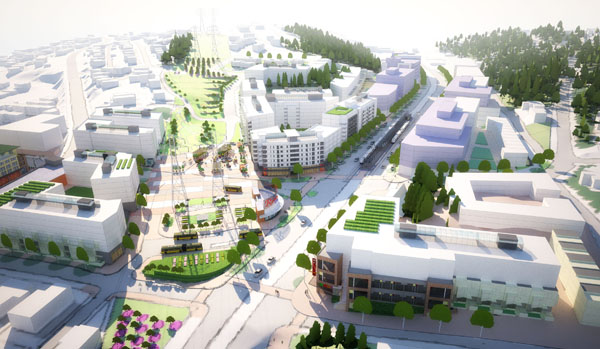
Full build-out of the Rainier Beach light-rail station area would create a balance of businesses and housing. (Image Credit: VIA Architecture)
It is widely established that concentrating growth near transit is a key strategy for sustainable urban development. Historically, planning for transit station areas has focused on housing rather than employment — when most people think of transit-oriented development, they picture dwellings above street-level retail.
In recent years, however, the value of planning for employment around transit has become increasingly recognized for several reasons. From a practical standpoint, jobs near transit boost ridership and help leverage transit investments. But more importantly, creating a healthy balance between employment and housing is essential for growing a complete community that maximizes opportunities for both residents and workers.
In some station areas the primary need is for new employment that builds upon the assets of the existing community and becomes a source of living-wage jobs for locals. In other cases, the main challenge is to avoid displacement of existing businesses. Industrial jobs are particularly challenging since they can conflict with residential uses, and often rely on the availability of cheap land.
Of course the catch is that there’s no easy formula for bringing high-quality jobs to desired locations. Do innovation districts just happen, or can the public sector help them along? My firm, VIA Architecture, recently engaged in two employment-based planning efforts that illustrate concepts and approaches, as described below.

Employment-based redevelopment near the Rainier Beach light-rail station would create an ideal location for a farmer’s market. (Image Credit: VIA Architecture)
Rainier Beach
Seattle’s southernmost Link light-rail station is in Rainier Beach, a highly diverse, relatively low-income neighborhood. Within a quarter-mile of Rainier Beach station are a handful of small businesses, and the housing is mostly single-family. There has been no significant redevelopment near the station since the trains started running in 2009.
The city recently completed a neighborhood plan that focused on opportunities in the station area. During this process, the community consistently expressed a high priority for redevelopment that creates high-quality employment that can improve economic mobility for residents, such as low-impact production, light-industrial, food-processing, education and incubator businesses.
To address this goal on the regulatory side, the city is developing new zoning that will incentivize educational, industrial and innovative commercial uses while promoting a vibrant, sustainable and walkable urban environment. Proposed zoning includes floor area or height bonuses for projects with the employment uses noted above, first-floor minimum height requirements for flexible accommodation of commercial uses and special allowances for loading.
With easy access to the industrial corridor that extends south from the Duwamish, Interstate 5, Sea-Tac Airport and downtown Seattle via light rail, as well as relatively low land costs, Rainier Beach is well situated for many types of innovative business pursuits. However, stakeholders also recognized the need to start with a specific sector that could leverage existing community assets for competitive advantage over surrounding areas, and the idea of a food innovation district rose to the top.
Rainier Beach is home to Seattle’s largest urban farm, and its diverse population provides a wealth of ethnic food knowledge. These assets provide a unique opportunity to leverage its light-industrial zone to become a hub of food and agricultural production, combining educational and training facilities with processing and distribution.
To catalyze the growth of a food innovation district, the planning team proposed an opportunity center for food education and entrepreneurship. This facility would combine commercial and training kitchen facilities, classroom space, office space, meeting areas, computer lab and community gathering space.
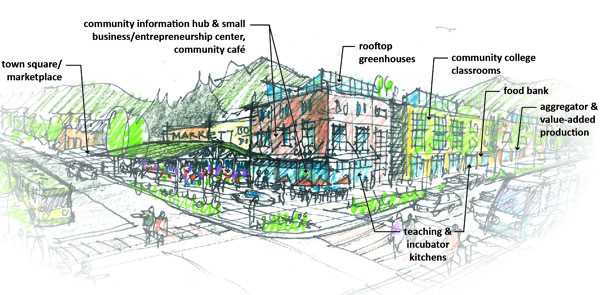
Conceptual sketch of the Opportunity Center for Food Education and Entrepreneurship. (Image Credit: VIA Architecture)
The city convened a workshop to gather input from potential partners and users of such a facility, including Seattle Tilth, the Emergency Feeding Program, Rainier Valley Food Bank, Project Feast and Fare Start, as well as the Seattle community colleges, Renton Technical College and Bainbridge Graduate Institute.
Input from the workshop led to a prototype building design. Unfortunately, the Rainier Beach station area lacks any existing building stock suitable to be adapted for the center, so new construction will be required. The next steps to implementing the center involve establishing partners, developing a business plan and space programming, securing a site and financing, construction, and lastly, operating the facility.
Portland ETOD
The Portland-Milwaukie light-rail extension, due to open in 2015, will have two stations in Southeast Portland’s Central Eastside, one of the city’s most important and dynamic industrial and employment centers. To address this unique environment, the city and its consultant team have been developing a new model for station area planning known as employment transit-oriented development, or ETOD.
The overall goal of the city’s ETOD approach is to strategically intensify and diversify the range of commercial uses on industrial lands, with the primary intent of increasing jobs, but also to leverage transit investments. At the same time, the city is intent on controlling land speculation, since high costs tend to push out many of the desired businesses. While there is already streetcar service in the Central Eastside, it is not another Pearl District, nor does the city want it to be.
A key strategy will be to reduce conflicts between the Central Eastside’s long-established businesses such as lumber and mill works, a dairy, and boat repair, while also welcoming an increasing number of new small, nimble technology and production companies that value a close-in location. These “makers†are seen as an important next generation of commercial enterprise whose employees are likely to bike commute and patronize the small-scale restaurants, bars and lunch spots that have begun to populate the area.
Another important piece of the ETOD puzzle is an intensification of land use in buildings that blend industrial and production uses on the ground floor with flexible office spaces on multiple floors above. The goal is buildings that can provide a delicate balance between a diversity of new businesses, and an industrial core of users that rely on lower land values to stay in business.

The newly constructed Pitman Building in Portland’s Central Eastside combines commercial kitchens with office space above. (Image Credit: Deca Architecture)
This configuration is already beginning to emerge in the Central Eastside, and one of the best examples is the newly constructed Pitman Building, with 11,000 square feet of space for six production kitchens on the first floor and 3,000 square feet of office space on the second floor. The area’s supply of historic buildings is also an asset, as exemplified in the recently renovated Ford Building, a former Model T assembly plant that now houses office, retail, artist studios, and a variety of small, creative businesses.
The role of partnerships
Lastly, partnerships between large institutions and the private sector are an essential ingredient for catalyzing true innovation districts. With the goal of creating an environment suitable for 21st century industry and providing meaningful occupation, many cities are establishing collaborations with universities that have a technical research and innovation focus.
For example, New York City has established a collaboration called Cornell NYC Tech, with Cornell, Teknion (an Israeli technical university) and Google. In Portland, there is a huge opportunity to tap into the synergies between the Oregon Museum of Science and Industry, Oregon Health & Science University, Portland State University, the burgeoning “makers†industry, and/or a corporate giant such as Nike.
The Oregon Museum of Science and Industry owns significant riverfront property adjacent to future light rail, and has great potential to leverage its location at a regional transit gateway and bring culture and complementary employment to the Central Eastside. In this case, the most advantageous outcome may be a new large tenant that would both benefit from and contribute to new synergies with existing business clusters.
>>>
Dan Bertolet is an urban planner with Via Architecture and is the creator of Citytank.
Note: This post originally appeared in the Daily Journal of Commerce.
When change occurs as rapidly as it has been in Seattle, misplaced blame runs rampant. And one of the most egregious examples is the contention that the construction of new housing is the cause of declining affordability—case in point, a coalition of Seattle neighborhood groups is currently advocating for a moratorium on new housing construction. But the reality in Seattle couldn’t be any more diametrically opposed: building housing at higher densities is actually a means to reduce the loss of existing low-cost housing.
To understand why, start with the data. According to the Seattle Department of Planning and Development, from 1995 to 2014, 68,433 new housing units were built and 8,724 units were demolished. That corresponds to a ratio of eight, meaning development is staying way ahead of the game in terms of net increase in housing, which helps affordability across the board by absorbing demand.
Furthermore, a nontrivial chunk of the demolishing likely had nothing to to do with housing redevelopment—the 8,724 includes units demolished for any reason, not just to make way for new housing. During 1996 to 2005 (newer data unavailable), over 25 million square feet of non-residential floorspace was developed in Seattle, and it’s reasonable to assume that some of that resulted in demolished housing. It is also reasonable to assume that some housing was demolished simply because the buildings had aged beyond their lifespan.*
While there is no question that housing development results in a lot more housing units gained than lost, it is also true that new housing is typically more expensive to rent or buy than old housing. And if new housing actually does take out existing housing, then the new units will likely be more expensive than the units that were lost. First, as alluded to above, to some extent this process is normal and cannot be avoided, because housing ages and eventually has to be replaced.
But second, and more importantly, it is a logical fallacy to conclude from this that housing development is inherently bad for affordability. Accurately assessing the impact requires a comparison to what would have happened absent the new housing. And in a high demand market like Seattle, the result would be greater competition for a limited supply of existing housing, which would drive up the rents, likely leading to renovation to meet demand for higher quality units. In other words, saving the existing units would not preserve their affordability for very long, and in fact, the system-wide effect would be a net loss in affordability caused by suppressed supply.
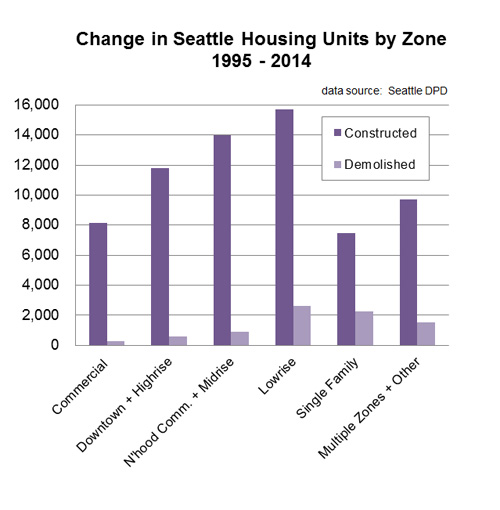
Looking at the housing data by zone in the above chart, it is clear that, on average, higher density development results in fewer units lost for every unit built. Given the basic math involved, that shouldn’t come as a surprise. The more housing units that get put on a given amount of land, the less likely it will be that existing housing will need to be demolished to make space for it. As can be observed through0ut Seattle,** most high density housing projects replace parking lots or spent commercial buildings, and not much, if any, housing.
Given the objective reality, it is remarkable how high density development is still so often a prime target of ire from people concerned about the preservation of affordable housing. Instead of pushing for further restrictions and fees that impede high density development and make it more expensive, these folks ought to be advocating for policies that promote building to the highest densities wherever possible. The same goes if the concern is about preservation of open space, tree canopy, or streams. Put simply, when we build up, there’s more room left over in the City (and the region) for other things we value.
In an analogous policy disconnect, high density projects are also the City’s biggest target for the extraction of development fees to offset their supposed “impacts.” But as the City’s own data show, the higher the density, the lower the impact on existing housing. A more sensible policy approach would place the tax burden of subsidizing affordable housing on low density properties, because inefficient land use is one of the root causes of Seattle’s affordability challenges.
The City’s ultimate example of misplaced blame is South Lake Union (SLU), which has long been a lightning rod for denunciation regarding affordable housing and gentrification. And last year SLU became the first neighborhood to be subjected to the City’s increased Incentive Zoning fees that are used to fund affordable housing. But guess what: From 2005 to 2014 (1995-2004 data were not parsed) there were 2,132 housing units built or permitted in the SLU zones, and only six housing units demolished. Not to mention the numerous subsidized affordable housing projects recently built in the neighborhood. It’s as if the City is intent on punishing the very places where things are being done right.
Lastly, none of this is saying that preserving existing buildings for affordable housing isn’t one of many potential strategies that the City policymakers should be exploring. However, we should not expect that the significant cost for the necessary subsidies can or should or be borne by a property owner who happens to own an old building. If the City wants buildings preserved to help meet affordable housing goals, then the City as a whole should step up and pay for it, and stop misplacing blame on housing development, which is actually part of the solution.
>>>
*For a quick thought experiment, assume that housing has a 100-year lifespan, and that Seattle built 300,000 housing units over 100 years and then stopped. At that point, the City would start to lose 3,000 units per year simply due to the lifespan of the buildings. For comparison, between 1995 and 2014, Seattle lost an average of 459 housing units per year to demolition.
**In this King5 news video, “monster” housing developments are vilified for causing loss of affordable housing, but the four projects shown that I could identify appear to have displaced a grand total of one housing unit!
Â
Council Study Reveals The Inherent Futility Of Incentive Zoning
Seattle City Council asked for a reality check on Incentive Zoning (IZ) and now they have their smoking gun:Â Since the Program’s inception in 2001, 62% of eligible development projects declined to participate. That outcome demonstrates that the IZ Program is not only fundamentally broken, but also has resulted in the loss of significant public benefits, and hindered progress towards the City’s own sustainable development goals.
 It’s pretty simple:Â Most developers said “no thanks” to IZ because the incentive offered by additional development capacity was not sufficient to offset the additional risk and cost. And one component of that additional cost is the requirement to include subsidized affordable housing in the project, or to pay for its construction elsewhere, a.k.a. an in-lieu fee.
It’s pretty simple:Â Most developers said “no thanks” to IZ because the incentive offered by additional development capacity was not sufficient to offset the additional risk and cost. And one component of that additional cost is the requirement to include subsidized affordable housing in the project, or to pay for its construction elsewhere, a.k.a. an in-lieu fee.
Given the historic low participation rate in IZ under its existing encumbrances, it would seem obvious that increasing the requirements for affordable housing will only tip the scales further toward non-participation, in which case zero affordable housing is produced. When the toll is raised, the gains made from the projects that still opt in to the Program will be offset by the increasing portion of projects that decline. And this inherent “diminishing returns” aspect of IZ is why it should never be expected to have a consequential impact on Seattle’s affordable housing needs.
I wrote “would seem obvious” above because apparently it is not obvious to Seattle City Council, and all indications are that some Councilmembers will be seriously considering either raising the IZ in-lieu fees (again), or more likely eliminating the in-lieu fee option altogether and thereby requiring developers to subsidize the full cost of including affordable units in their projects.
In the South Lake Union neighborhood, Council recently imposed in-lieu fees that are up to 43% higher than the historic fees in downtown, and what is the result so far? Of 20 eligible development projects in the pipeline, 14 are not participating—a no thanks rate of 70%. South Lake Union could be considered a best case scenario for IZ, since it is one of the hottest real estate markets in the country. But even under ideal market conditions, for most projects the incentive was insufficient to overcome the encumbrance.
Based on the estimates of Council’s affordable housing consultant, mandating inclusion of affordable units in projects would be equivalent to jacking the in-lieu fees by a factor between about two and four.* It’s hard to conceive how this would not lead to a precipitous drop in IZ program participation. And again, that would result in even less affordable housing produced, along with underdevelopment in urban centers that runs counter to Seattle’s Comprehensive Plan, as well as regional goals for sustainable growth. Same goes for tweaking IZ to require affordability levels deeper than 80%AMI (i.e. where the real need lies)—the opportunity cost to developers will rise significantly due to the greater requisite subsidy, and the IZ participation rate will drop.
Since 2001, IZ in Seattle has generated about $27 million from in-lieu fees, which resulted in the production of about 600 affordable rental units, if the effect of leveraging funds from other sources is included. Council’s consultant predicts that because funding sources that have been leveraged in the past are drying up, from here on out the City should anticipate about a doubling of their expenses to produce affordable housing*—in other words only about 300 units could be produced from that $27 million. For reference, $27 million would cover the turn-key production costs of only about 110 typical multifamily units. To put those numbers in perspective, during that same time period, some 46,000 multifamily units were built in Seattle.
Some would argue that even though IZ produces a miniscule amount of affordable housing relative to the need, it’s still better than nothing. But this argument becomes indefensible when you consider the negative impacts of the underdevelopment that IZ can cause. The Downtown Seattle Association has published estimates of a wide range of public benefits that were forgone based on 25 projects in downtown and South Lake Union that opted to not participate in the IZ program, illustrated below:
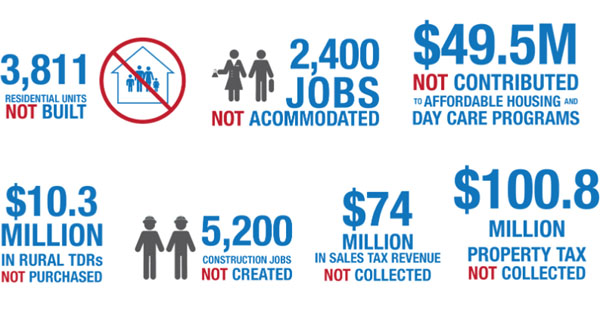
City Council must be held accountable for putting this magnitude of public benefit at risk through the imposition of IZ. Granted, the added encumbrance of providing affordable housing is only one of many reasons developers might opt to forgo the maximum development capacity allowed through IZ. But those other factors will always be part of the development equation. And in any case, piling on affordable housing is guaranteed to tip the scale in the wrong direction, especially if the requirements are made more onerous, which is the direction the political winds are blowing.
The potential sacrifice of 3,811 new housing units is the most glaring illustration of how IZ is an intellectually bankrupt policy. The biggest driver of Seattle’s current housing affordability crunch is demand outstripping supply. When thousands of new housing units go unbuilt, that means thousands more households competing for existing housing, and at the end of the day, it will be the poorest households that get priced out. And it also means thousands more housing units likely to end up built in sprawling outlying areas.
To sum it up with bad cliches, Incentive Zoning is like trying to squeeze blood from a stone, and robbing Peter to pay Paul, and shooting yourself in the foot, all rolled into one. Given that in this case the stone is such a politically expedient scapegoat, there is no question that City Council’s life would be easier if the above cliches weren’t so apt. But the sooner Council accepts the inherent futility of IZ, the sooner they can get on with the hard work of developing better housing affordability strategies—that is, strategies that—unlike IZ—encourage market production of housing supply to help ease prices, have the potential to generate funds for subsidy commensurate with the need and cost, and place the tax burden on all property, not just new development.
>>>
*The Cornerstone Partnerhip’s estimates provided to City Council: Opportunity cost to developer of affordable units built in project = $100k – $200k/unit; In-lieu fee = $56k/unit; Historic cost to City = $44k/unit; Future cost to City = $95k/unit
>>>
This post originally appeared at Smart Growth Seattle.
Workforce Housing in Seattle: Myth vs. Reality
For the better part of the past decade, both advocates and policymakers have been decrying Seattle’s perceived lack of housing affordable to people with incomes in the lower-middle range—so-called “workforce housing.” As a result, Seattle has implemented and is continuing to expand a program known as Incentive Zoning intended to create subsidized workforce housing through fees imposed on new development.
But there’s one rather important thing wrong with this picture:Â Available data show that there is no shortage of workforce housing in Seattle.
For reference, workforce housing is typically defined as housing that is affordable to households with incomes between 60 and 100% of area median income (AMI). In Seattle, 80% AMI corresponds to $49,440/year ($24/hour) for a single-person household. Assuming the standard that 30% of income is spent on housing, that translates to an “affordable” rent of up to $1342 per month.
For all the attention workforce housing gets, there’s surprisingly little up-to-date, hard data available on how much housing is out there priced at workforce affordability levels, compared to how many households there are that need it. King County analysis based on a 2009 survey of market-rate rentals found that a whopping 83% of units in Seattle were affordable to a household earning 80% of AMI. For 50% AMI, 37% of Seattle’s rental units were affordable. Across King County and the greater region, data reveal a similar pattern of excess housing supply at workforce income levels, along with a sharp increase in need the further income drops below workforce levels.
Based on the raw numbers there would seem to be plenty of existing workforce rental housing in Seattle, but one complicating factor is that some households may be renting housing that is cheaper than what they could afford according to the standard 30% formula. This “downrenting” has the effect of reducing the availability of housing that is affordable to lower incomes. The affordable housing advocacy group Housing Development Consortium has published some analysis by the Seattle Office of Housing on downrenting, and the results are summarized in the table below:
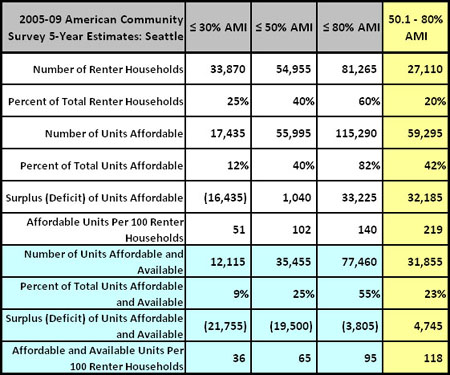
Looking specifically at households with incomes between 50 and 80% of AMI (yellow column)—which is the lower portion of the workforce range—there was a surplus of over 32,000 housing units with affordable rents. Put another way, for every 100 households in the 50-80% AMI range, there were 219 affordable rentals in Seattle.
After subtracting the number of units being rented by households earning more than 80% of AMI, there is still a surplus of 4,745 rental units affordable and available to 50-80% AMI households; for every 100 households in the 50-80% AMI range, there were 118 affordable and available rental units in Seattle. In other words, even when downrenting was accounted for, there was still no shortage of workforce housing.
Since 2009 housing costs have risen faster than incomes, so current data would likely show some reduction in affordability. And rents vary significantly between different neighborhoods. But even with those caveats, it’s hard to imagine how anyone could interpret the available data as proof of a dire need for programs to subsidize workforce housing in Seattle. Yet currently Seattle City Council’s affordable housing efforts are focused on an extensive examination of how to do exactly that using Incentive Zoning. Here’s how Council justifies it:
For example, a public school teacher’s starting salary of $42,000 suggests that he or she should not pay more than $1,050 per month (30%) for housing. Yet the average rent in Seattle for a 2 bedroom / 1 bath apartment is $1,466.
That’s right, we have a workforce housing crisis because a single person earning far less than the City’s average income can’t afford the City’s average rent for an apartment with an extra bedroom, never mind the half of the housing stock that rents below the average. And so apparently therefore we need to exact a toll on new development through Incentive Zoning so that someone making up to $49k can live in a subsidized apartment in a brand new downtown high rise. Seriously—if any of you reading this were in those shoes, would you feel entitled to that?
Meanwhile Council balks when it comes to solutions that would support meeting workforce housing needs through private development—no public expense necessary—such as microhousing, accessory dwelling units, meaningful upzones in lowrise zones, removing off-street parking requirements, and other strategies that could reduce the cost of producing housing.
In previous posts I have pointed out the numerous flaws in Incentive Zoning—how it defeats its own purpose by restricting supply and increasing the cost of housing production, how it’s based on an outdated paradigm that sees dense development as negative impact to be mitigated rather than a critical sustainability solution, and how its inherent limits preclude it from ever generating more than a drop in the bucket relative to the need.
Now we can add to that list of flaws the fact that Seattle’s Incentive Zoning Program was designed to subsidize workforce housing, even though the data indicate that the City already has enough. Available workforce housing may not be brand new housing. But even if new housing has rents higher than workforce affordability levels, it will still help preserve the availability of workforce housing by absorbing demand from a high-income renter who would otherwise be competing for, and driving up the prices of existing housing.
The City’s real housing need is at the deeper affordability levels, as the data clearly show an increasing deficit of affordable rentals as incomes drop below 50% AMI (see data table above). And yet another pitfall of Incentive Zoning is that even though it doesn’t address the real need, it creates the false impression that electeds are taking meaningful action to solve a housing problem. That is, Incentive Zoning is a politically expedient distraction.
To sum it up succinctly: Why are we applying an counterproductive tool to solve a problem we don’t have? We can and must find better solutions to address Seattle’s actual affordability needs.
>>>
P.S. For brand new info on the ineffectiveness of Seattle’s Incentive Zoning Program, check out this presentation by the City’s consultant, who found that 62% of of projects eligible for the incentive have opted not to develop the additional floor area. In other words, for most projects the Program is not an incentive because the fees are already too high.
>>>
This post originally appeared at Smart Growth Seattle.
Why Building Housing In Seattle Is Essential For Social Equity
One of the biggest threats to social equity in Seattle is a shortage of housing. Because when demand for housing overwhelms supply and drives up prices, it is the poor who lose. And the essential solution is this: build more housing.
Landlords and developers both do well in a seller’s market for housing. And the affluent are fine too, because they can always outbid those with less financial means for the limited housing that is available.
But the people who do not fare well are those in the lower end of the income spectrum, who are denied access to the all the opportunities and benefits of living in a a prosperous city like Seattle. When demand is not met by supply, inflated prices across the board put housing increasingly out of reach. And those with the lowest incomes are always priced out of the market the soonest and the furthest.
To be clear, government subsidy for housing is also necessary for the deeper levels of affordability. And due to high costs of production, new housing can often be too expensive for a significant portion of lower-income households. Nevertheless, in a high-demand housing market like Seattle’s, increasing the supply of market-rate housing is imperative for equitable access to housing. Here are ten reasons why:
- First of all, increased supply puts downward pressure on prices throughout the housing market, and that preserves affordability for more households.
- Because supply enable more households to find an affordable option, limited funds for housing subsidy can go further to provide more financial help for the lowest income households who need it most.
- More housing means more choices for people to find an affordable housing option that fits their unique needs, such as microhousing.
- Even expensive new housing helps, because every high-end unit that’s produced absorbs demand from a wealthy consumer who otherwise would be outcompeting those with lower incomes for existing housing.
- Likewise, even if new housing units are small they still absorb demand, which reduces competition for existing single family houses, and preserves more options for families with children to live in the city.
- When new housing is provided near good transit, more households have the option to go car free, which significantly reduces household expenses.
- When new housing is not available, demand will induce renovation of older housing, thereby removing it from the affordable stock.
- More housing expands the tax base and increases funds available to subsidize housing for the lowest income households through programs such as Seattle’s Housing Levy.
- The cost and financial risk of building housing falls on private developers and lenders, not on cash-strapped municipalities—social equity is improved with very little public expense.
- Lastly, in the bigger picture, increasing housing supply in Seattle supports widely adopted sustainable development goals to address sprawl, energy, and climate change, all of which disproportionately impact the less fortunate, whether at the local, regional, or global scales.
In comparison to the above list, the purported downsides of housing development are less tenable. One commonly cited concern is displacement of existing affordable housing. But most of the larger multifamily infill projects in Seattle are built on empty lots or spent commercial buildings, and do not cause any such displacement. In cases where new housing would take out existing low-rent units, preventing the development is likely to be a short-lived victory. Because if the location is desirable, the resultant pent-up demand will inevitably accelerate rent increases in any housing that was preserved.
In Seattle, most of the negative noise over new housing is about the impact on neighbors—views, shadows, aesthetics, undesirable tenants, parking, traffic. And what it boils down to is a choice between those who were lucky enough to get theirs first in Seattle, and those with limited financial means who want to find a place to live here now. If social equity is truly the goal, then the latter group must be given priority.
These battles over growth have played out countless times in Seattle, the current example being the debate over rolling back recent upzones in low-rise residential areas. If City Council decides in favor of those who wish to restrict housing development, we should all recognize that they will also be deciding against social equity.
The trends that are creating strong demand for housing in Seattle are not going away any time soon. Seattle has a massive, ongoing need for new housing to meet this demand and control prices. If supply continues to fall behind, not only will more lower-income households be priced out, but the subsidy required to make up for the widening affordability gap will increasingly eclipse available City funding resources.
If there was a shortage of shoes that drove prices so high that only the wealthy could afford good shoes and the poor were going barefoot, it would be obvious that increasing shoe production should be a priority to improve social equity. So too, with housing.
>>>
Photo of new housing at 13th and Pine on Capitol Hill by the author. This post originally appeared at Smart Growth Seattle.
Getting High In Residential Transit Station Areas
About 6 miles from downtown Vancouver just inside the eastern city limits is a residential neighborhood called Collingwood that looks like this from the SkyTrain:
And this:

And this:

And for perspective, a 2008 birdseye view of the whole area:

As I wrote back in 2008, this is what transit-oriented development (TOD) looks like:
Collingwood balances density with amenities: it has seven acres of park, an elementary school, a “neighborhood house,†a community gymnasium, and a daycare. It offers a variety of housing types at both affordable and market rates, with 20% of the units designed for families with children. There are towers ranging from 17 to 20 stories mixed in among 4- and 6-story mid-rise. Lower buildings and a park face the single-family zone to the south.
UPDATE:Â Collingwood has become the densest neighborhood in Vancouver.
What’s conspicuously lacking from the built environment, both in Collingwood and throughout Vancouver, is the Seattle “breadloaf”—the 6- to 7-story mixed-use residential building type that has become ubiquitous in Seattle’s growing urban villages. During my recent Vancouver tour I only spotted one, near the Commercial-Broadview SkyTrain station:
The difference between Collingwood and any TOD in Seattle outside of downtown—existing or planned—couldn’t be any more stark. The Collingwood SkyTrain station is about the same distance from downtown Vancouver as the Othello LINK light rail station is from downtown Seattle, but in contrast to a station flanked by ten high-rises, at the Othello station area the maximum building height is only 65 feet, and only one large-scale private development has been completed since the trains started running 4.5 years ago.
Two stops closer to downtown Seattle at the Mount Baker LINK light rail station area, the City began a planning process in 2009 that culminated in a recommendation for an upzone to heights up to 125 feet in a small portion of the station area. But in late 2013 a Council vote on it was derailed by 11th-hour neighborhood opposition. At the future LINK station due to open in 2021 in Northgate, about 7 miles north of downtown Seattle, heights up to 125 feet are allowed in some areas, though there have been no takers yet—only mid-rise breadloaves so far. At the future LINK light rail station on Capitol Hill, the City’s highest-density residential neighborhood outside of downtown, all that the community could agree on was a meager height increase from 65 to 85 feet.
Demand for housing in Seattle is not going away any time soon. And if we can’t build up, we will build out. Inside the city that means increased development pressure on underdeveloped or underutilized properties, including housing that is relatively affordable. Outside the city that means more sprawl and loss of farms and forests.
As with my previous posts on downtown Vancouver and Vancouver suburbs, I am not claiming that Vancouver’s urban form is perfect, nor that high-rise is a cure-all that belongs everywhere. My point is that if Seattle hopes to grow into the most sustainable city possible, high-rise will have to play a much larger role than it has. And Seattleites need look no further than the city across the border to see that it can work well. But if fear of heights continues to rule the day, ultimately both the City and the planet will suffer for it.
>>>
All photos except the birdseye taken by the author from the SkyTrain.
In The City in History (1961), Lewis Mumford describes the “regional city” as an alternative to formless, auto-oriented sprawl. The regional city consists of a central major city encirled by a network of smaller satellite cities, all connected by rapid transit. Apparently greater Vancouver, BC, was listening.
The photo above is in Burnaby, the first city east of Vancouver along the Skytrain line. It looks as if a section of downtown Vancouver was imported. No fear of heights here. In the photo below, a brand new 46-story residential tower rises from a sea of low-density housing adjacent to the Metrotown Skytrain station. Density near transit—pretty simple.
Continuing east by Skytrain, the next node is the City of New Westminster on the Fraser River:
It’s a city in transition, but again, they aren’t afraid to make big and bold—that is, tall and high-density—moves with their new buildings:
The 37-story triple tower project shown below, known as Plaza 88, is completely integrated with the New Westminster Skytrain station and bus terminal:
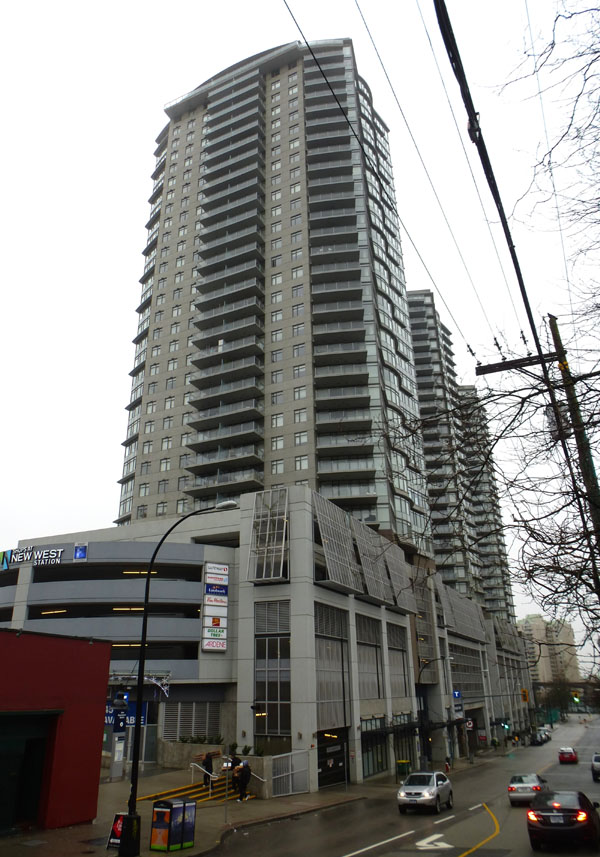
Imagine that instead of a huge surface parking lot and some scattered low-rise apartments and strip malls, there were half a dozen high-rise towers clustered around the Sound Transit LINK light rail station in Tukwila. That’s the difference between how the greater Vancouver region does things, and how the greater Seattle region does things.
And it’s why greater Vancouver will continue to be a more sustainable region for decades to come.
>>>
All photos by the author, taken on a dreary gray December day in 2013.
Will The New Mayor Inspire Seattle To Rise Above Fear Of Change?
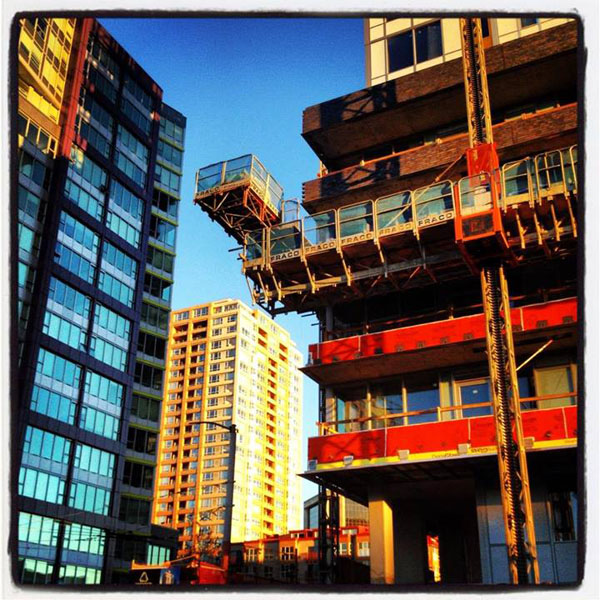
Note: I was invited by Seattle Met magazine to contribute to a series of short essays offering advice to Seattle’s new mayor. It’s now on the stands in the January 2014 issue, and here’s the raw version of mine…
>>>
Seattle is on a roll. Great people want to be here. Great businesses want to be here. As human energy pours into Seattle, the one sure thing is change. And what the new mayor needs to do is lead Seattle in embracing that change, rather than fearing it.
Because buildings are so tangible, development is one of the most polarizing aspects of change in Seattle. And when people respond from the perspective of fear, all they can think about is how big new buildings are going to make things worse.
The alternative is to see Seattle’s prosperity and the development it induces as the phenomenal opportunity it actually is. With all the potential for growth in Seattle, the prospects have never been better for creating one of the most sustainable cities on the planet, while at the same time abating sprawl’s decimation of the greater region.
As with every human endeavor, development sometimes comes with warts. But if the fear-driven reaction is to attack developers, everyone will lose in the end. And those hit hardest will be the poor, because when demand for new housing outstrips supply prices skyrocket, and the result is a city accessible only to the wealthy—case in point, San Francisco.
The next major’s task is to inspire Seattleites to rise above fear of change, and channel their abundant passion and creativity into positive collaboration on development that will set a national example for how cities can grow in a way that benefits everyone.
>>>

Construction photo by Darick Chamberlin.
Why is the trend of decreasing auto use shown below happening in downtown Vancouver, BC, even as population and jobs have risen?

Because of this:
That is, lots of tall residential buildings. That is, density.
Vancouver BC is not afraid of height. They’ve been successfully weaving towers into their neighborhoods for decades, as on this quiet West End residential street:
Towers everywhere you turn:
Sleek towers:
Weird towers:

Shortish towers:
And they just keep building more:

And even with all that height, downtown Vancouver is an amazingly comfortable place to be a pedestrian, mainly because most of the towers are relatively slender, and there’s lot’s of space between them. All the urbanist Vancouver hype is well-deserved—the City’s urban form is truly unmatched.
Meanwhile, in the big city a couple hours south of the border, height is still a dirty word. And the result is not only squandered opportunities for density and all its sustainability benefits, but also a more oppressive urban form of chunky, squat buildings crammed in together.
Why is Seattle so afraid of height?
>>>
Source of Vancouver chart: Vancouver Transportation 2040. All photos by the author, taken in downtown Vancouver 12/11/13 — 12/13/13.
Getting Real About The Costs And Benefits Of Affordable Housing
One of the many complex facets of subsidized affordable housing is the question of where it should be located. Ideally, every neighborhood should maximize equitable access to opportunity by accommodating a complete and balanced spectrum of household incomes. But the conversation can’t end there, because getting real about that ideal means grappling with thorny cost versus benefit choices.
The first cost reality to consider is that the more expensive the neighborhood, the more subsidy it takes to provide an affordable housing unit—in many cases a lot more. As an example, according to the Seattle Office of Housing, the maximum rent for a 1-bedroom apartment affordable to a household earning 80 percent of area median income (AMI) is $1301 per month. In a typical Seattle neighborhood a new market-rate 1-bedroom might rent for let’s say $1400 per month, which means the required subsidy is about $100 per month. But in an expensive neighborhood such as South Lake Union (SLU) in Seattle, a 1-bedroom unit is more likely to rent for something like $1800, which translates to a subsidy of $500 per month. Assuming a 50-year commitment, for a $300,000 investment the City gets either five subsidized units in a typical neighborhood, or just one subsidized unit in SLU.
On the benefits side, there is no question that when housing prices get too high in successful urban neighborhoods, people with lower incomes may lose access to a wide range of important resources, including jobs, transportation, education, health, safety, open space, community groups, entertainment, and recreation. Access to good transit is particularly important because the expense of relying on a car ownership sucks up a larger portion of the income of poor people (see footnote). These are all very real social justice issues.
The most commonly proposed solution is regulation that requires developers to include affordable units in their projects and absorb the cost of the subsidy—so called “inclusionary zoning.” Legal opinion differs on the legality of pure inclusionary zoning in Washington State, so the usual alternative is “incentive zoning” that grants “bonus” development capacity in exchange for including affordable housing in the project. Most programs also have the option of a fee “in-lieu” of including on-site affordable units, and in Seattle many advocates want fees raised so high that developers are compelled to choose the inclusionary option, since that is the only sure way to ensure economic integration in expensive neighborhoods. But given that in Seattle some developers are already deciding that the extra capacity is not worth the fee at the current fee levels, a major hike in the fee would all but guarantee that bonus capacity would be left on the table and no affordable units would be built.
The City of Seattle has a goal that 37 percent of all housing should be affordable to households with incomes at 80 percent of AMI and below. It’s a huge leap to assume that that goal should also apply to every Seattle neighborhood on an individual basis, but nevertheless Councilmembers Licata, O’Brien, and many others did just that when recently pushing for higher developer fees in SLU. That scenario might be best in an ideal world, but as discussed above, it’s going to cost a lot more to cover the subsidy for those units in SLU than it would for units located in less expensive neighborhoods. And if it means the City ends up with a lot more affordable housing elsewhere, would it really be such a terrible thing for people to commute to SLU from other neighborhoods, just like the tens of thousands from across the income spectrum who take the bus into downtown from all over Seattle every day?
Once that first dubious leap is made, it leads to another—that the burden of paying for all the affordable housing to be built in SLU should fall on private developers, in the form of either fees, or inclusionary affordable units built into market-rate projects. The City estimates a need of 4,200 affordable units for SLU’s workers by 2031, and if we assume for argument’s sake that these units would have to be subsidized by $500/month for 50 years, that comes out to about $1.3 billion that would have to be extracted from new development—in just this one neighborhood. For perspective, that $1.3 billion is about ten times Seattle’s 7-year housing levy that spreads the tax burden to every property owner in the City.
The above expectations are a recipe for counterproductive results: Incentive zoning simply doesn’t have the capacity to generate that scale of subsidy, and if requirements continue to be expanded in the vain hope of doing so, the resulting encumbrance on development will end up so high that most if not all developers will have no choice but to decline to build additional capacity. And that would result in either zero new inclusionary affordable housing, or zero in-lieu fee revenue to fund affordable housing, as well as reduced housing supply that would aggravate affordability across the board and compromise local and regional sustainable growth goals.
Seattle cannot hope to make real progress on affordable housing when there is such a massive gap between policy goals and the resources available to achieve them. While there is a strong consensus on the need and value of affordable housing, the path to that end remains unclear. Most of the basic questions are unresolved:Â How much do we need to subsidize and at what affordability levels? How much will it cost? Where will the money come from? What are realistic limits given budgetary constraints? What are costs versus benefits compared to other demands on public dollars? How do we even define what affordability means?
Closing the gap between aspirations and limitations calls for an integrated, system-oriented effort to set realistic goals, establish new funding sources for subsidy, and accelerate the production of housing supply in the private market.
The most straightforward piece of the puzzle is increased housing supply that puts downward pressure on prices across the board and reduces the gap that has to be covered by subsidy. And all it takes is avoidance of policies and regulations that place unnecessary encumbrances on development, so that the private market can do what it does best—innovating to meet demand with efficiency and reduced cost.
Given political sensitivities, recalibrating goals is likely to be more challenging. It might mean acknowledging that subsidy should be focused in less expensive neighborhoods to get the most housing for the money. Or reconsidering whether affordable housing for the 80% AMI income range should even be subsidized at all. Or redefining affordability to account for the reduced transportation costs in transit-rich locations.
But without a doubt, by far the most challenging piece of the puzzle is funding. Step number one for Seattle is to recognize that programs such as incentive zoning that tax new development are not only counterproductive to their own intent, but will never come anywhere close to meeting the need even in the ideal case (that doesn’t exist). The Housing Levy spreads the burden more fairly, but it too falls woefully short of the financial need.
It will be a massive undertaking to establish new sources of funding for affordable housing subsidy that are commensurate with the need, but the simple fact is it must be done. I don’t have all the answers, but hope to expand the conversation in future posts, and I want to challenge everyone to come up with innovative ideas. Because I am sure that Seattle will fail on affordable housing if we don’t start thinking much bigger than we have been.
>>>
Footnote: Another commonly cited reason to support inclusionary affordable housing is the reduction in greenhouse gas (GHG) emissions resulting from fewer low-income people having to commute long distances by car from places with cheaper housing. However, this reasoning overlooks the fact that when an inclusionary unit is produced through incentive zoning, it replaces a market-rate housing unit. And since the people that would have been living in the eliminated market-rate unit are potential car commuters too, the inclusionary unit is unlikely to result in a net reduction in driving or GHGs. It also overlooks the fact that in a city such as Seattle with good transit, commuting to a job center from another city neighborhood need not involve a car at all.
GHG reductions are primarily determined by the total amount of housing that is added to a transit-rich, mixed-used neighborhood. (And that’s one of the many reasons why it’s so important to minimize policies—such as taxing new development—that impede the production of housing.) At the scale of the entire City, a lack of affordable housing can be expected to lead to greater GHG emissions caused by longer car commutes from beyond Seattle. But at the individual neighborhood scale, climate change is not a defensible rationale for inclusionary requirements. Of course that doesn’t negate the potential equity benefits.
The Mixed Messages and Misplaced Burden of Taxes on New Development
Note: This post is part of an informal series that addresses the interplay between development, regulations, housing supply, and affordability. See the rest here.
>>>
In a previous post I probed the dark depths of Seattle’s Land Use code to critique the convoluted, but lawyer-approved logic that is officially put forth to make the case that additional development capacity causes adverse impacts that must be mitigated by developer fees. But most people who support exacting developer fees to pay for public benefits have a rationale that’s less arcane, though trickier to unpack.
The basic idea is that when a city changes regulations or makes public investments that increase the value of development, then the public has a right to capture some of that value to use for much-needed public benefits such as affordable housing. It all sounds quite reasonable on the surface, but unfortunately, upon closer examination it becomes hard to ignore that this approach is likely to be self-defeating.
The most common instance is when a city changes zoning to allow more development capacity, which lets a developer build a larger building and presumably make more money. That value is a viewed as a public gift to the developer, which justifies the public taking some of it back in the form of a special fee.
One hole in the above rationale is that an upzone doesn’t really create any value at all—it merely removes regulations that were preventing value from being realized. The actual source of the value is demand for new buildings from people who want to better their lives by living and working in a great city. Furthermore, existing zoning was not written in the sky—it’s a more or less arbitrary restriction that destroyed potential value when it was enacted.
But the fundamental flaw in the rationale for charging a fee for additional development is that the reason upzones are done is not to benefit developers, but to enable outcomes that benefit everyone—at the local, regional, and even global scales.
The debate is over: Absorbing growth in urban centers is the first and foremost strategy for sustainable development in growing places such as the Puget Sound region. That’s why cities upzone.
But when we put a toll on the additional capacity granted by an upzone it totally contradicts the original intent. The reality is that such encumbrances can be expected to either drive up rents or, if the fees are high enough, cause developers to opt against building additional capacity. And every new housing unit that is not built in a dense, transit-rich urban center means one more housing unit that is likely to end up in a less sustainable place. And every potential housing unit that is not built in a high-demand market such as Seattle means housing supply becomes more restricted and prices rise faster, hurting everyone, especially the poor.
Likewise, public investments in roads, light rail, or parks benefit everyone, not just developers who have projects nearby. In fact, one could argue that businesses gain a lot more than developers do from mega road projects such as Seattle’s deep bore tunnel, since transportation improvements are all about providing better access to jobs for commuters. Of course all businesses—including development firms—already help pay for public investments through existing taxes. And the higher property value and new jobs that result from development projects generate even more revenue from those existing taxes, property tax in particular. Indeed, for any given piece of land, the greater the development capacity, the greater the potential tax revenue. Here again, developer fees discourage maximizing the public benefit from a given piece of land.
Seattle’s expanding light rail system will boost the value of surrounding property, but that doesn’t mean it should be a target for extraction. It’s actually a good thing if increased value makes development more attractive, because those areas are exactly where we want development to happen. Light rail investments remain vastly underutilized until there’s lots of housing and jobs built up around the stations. But at the future light rail station in Seattle’s Capitol Hill neighborhood, for example, the City has encumbered the adjacent properties with a heavy list of public benefits—including affordable housing—that will be required as a condition of additional development capacity. Time will tell how realistic those expectations are. (As an aside, a similar scenario of inflated expectations is currently playing out in Yesler Terrace, but that’s a long story.)
For some perspective on what Seattle’s current regulations require from private developers to subsidize affordable housing, the developers of a recently proposed downtown hotel/convention center project would have to write a check for $12.4 million to be allowed to build their desired additional capacity. For comparison, that $12.4 million burden on a single development project is equivalent to almost 10 percent of Seattle’s total seven-year Housing Levy. The burden of the Housing Levy—shared between all of the hundreds of thousands of property owners across the entire City of Seattle and spread over seven years—looks pretty puny in comparison.
All property owners in Seattle are seeing huge personal gains in terms of property value appreciation that is being driven by the success and desirability of Seattle. At the same time, that appreciation is the cause of Seattle’s housing affordability challenges. And that’s why the Housing Levy is a defensible source of affordable housing subsidy that ought to be expanded—it spreads the burden fairly among all those who are basically hanging around and benefiting from Seattle’s success just because they got in first. In contrast, taxing new development unfairly dumps the burden on a very small subset of newcomers who are actually part of the sustainability and affordability solution.
But guess what? Right now, the Seattle City Council is in the process of raising Seattle’s downtown developer fees even higher, just like they recently did as part of the South Lake Union rezone. Neither the Council nor the Mayor’s office seem to be interested in thinking about whether or not taxing new development is a sound policy, or if it could do more harm than good. The only debate is over how much more they can squeeze out of developers.
All in all, it’s pretty simple: A sustainable future hinges on accommodating as many people and jobs as possible in urban centers, and we have no choice but to rely on private developers to build what that requires. That means it’s just really not very smart to treat developers as adversaries. Yet the message Seattle’s policy makers are sending to developers is this: Please build our city so that we can meet our goals for sustainable growth, but we will behave as though your developments are adverse impacts that need to be mitigated, and while you take on all the financial risk, we will impose fees that determine how much profit you can make.
The message ought to be: How can we work with you so that everyone wins? And for one example of that approach look no further than Tacoma, where the lack of development gives quite a different perspective on developers, and where the City is pursuing downtown Subarea Plans that will provide State Environmental Policy Act (SEPA) pre-approval for all development projects. They also removed all off-street parking requirements in their downtown, and created a development authority for the Foss Waterway. In other words, Tacoma is being as proactive as possible to make it easier for developers. And that’s what it’s going to take if Seattle doesn’t want to wait a lifetime for significant development to happen in key locations such as the southeast Seattle LINK light rail station areas, for example, where the real estate market is marginal.
Will making it easier for developers increase developer profit? Yes. But if the increased potential for profit leads to more development projects moving forward, leads to more buildings going up in urban centers where they belong, leads to less underdevelopment of invaluable urban sites, leads to increased housing supply and the resultant downward pressure on housing prices, leads to greater tax revenue that can be used for public benefit such as affordable housing or other social services, leads to more efficient transit and reduced greenhouse gas emissions from cars, leads to a reduction in sprawl swallowing up farms and forests, well, maybe they deserve it?
Welcome To The Affordable Housing Policy Twilight Zone
Though I’ve done no small amount of keyboard clacking questioning the sanity of taxing new development to fund affordable housing (see here, here, here, and here), I’ve not delved much into the official rationale offered up to support it. Not pretty, that rationale. And for a prime example, check out this language on “incentive zoning” in the City of Seattle’s land use code:
The purpose of this section is to encourage development in addition to that authorized by basic zoning regulations (“bonus development”), provided that certain adverse impacts from the bonus development are mitigated. Two impacts from additional development are an increased need for low-income housing to house the families of downtown workers having lower-paid jobs and an increased need for child care for downtown workers.
Further down the page, the intent is restated:
[Affordable] housing provided through the bonus system is intended to mitigate a portion of the additional [affordable] housing needs resulting from increased density…
In other words, those who develop new buildings are being held responsible to help pay for housing and daycare for people who get downtown jobs that are created as a result of that new development. In other words, creating housing and jobs in downtown is a bad thing that must be mitigated by those who do it. Never mind that creating housing and jobs in transit-rich urban centers such as downtown Seattle happens to be a universally established imperative for sustainability.
For an analogy, it’s as if we exacted a special tax on computer manufacturers to subsidize internet service, the rationale being that an additional need for affordable internet service is an adverse impact caused by the production of computers.
In that scenario we’d no doubt hear plenty of protest over how such a tax would increase the cost of production and make computers more expensive for everyone, and how higher prices would hit poor people the hardest and negate the benefit of the subsidized internet service. And I suspect that people would also be a lot more likely to ask why computer manufacturers should be singled out to bear the burden of subsidizing internet service when they are already providing public benefit by making computers.
For the case of affordable housing parallel objections apply, but it’s even worse than the computer analogy because there’s also the risk that developer fees will impede development and suppress housing supply, which will drive up prices even further. Assuming the need for subsidy is real—which in the case of affordable housing I believe it clearly is—the obvious solution to both scenarios is to develop alternative sources of subsidy that don’t compromise the original intent. But since that is likely to involve significant effort, the first step is a come to Jesus about what’s wrong with the current approach (hence my recent obsession).
If downtown Seattle grows, math dictates that there will be more people with downtown jobs, including those with “lower-paid” jobs. Since the City of Seattle has adopted a plethora of goals and policies to promote growth in downtown, then the City of Seattle as a whole should bear the burden of “impacts” such as increased need for affordable housing. By building in Seattle’s urban centers, private developers are only doing what the City supposedly wants them to do, and the fact is, they are the only ones who can do it. In this light, regulations that penalize development—that essentially say “growth is bad” and ignore all the public benefits—are pure schizophrenia.
I acknowledge that the land use code quoted above was a well-intentioned effort to justify a source of much-needed affordable housing subsidy. But can we really afford to ignore the twisted paths down which that rationale leads us? In addition to the fundamental flaws described above, my mind goes dizzy with the implied questions:Â What would happen to all those “lower-paid” workers absent the new development? Would they be better off somewhere else? Would the City or region be better off if those jobs were somewhere else, say, low-density, car-dependent suburbs? On the other hand, does new development somehow coerce workers into taking downtown jobs? Why stop at housing and daycare? Pretty much everything is more expensive in downtown Seattle—should developers also be subsidizing parking, or lunch?
Another wacky feature of incentive zoning is that it only charges developer fees on the “bonus development.” That means the rest of the building gets off scot-free, even though any perceived adverse impacts related to affordable housing caused by the rest of the building are exactly the same as those caused by the bonus development. (There are legal reasons for this, but that doesn’t make it any less incongruous.) On top of that, in Seattle the relative portions of the building charged versus not charged a developer fee varies widely, depending on what particular zone you happen to be in.
Might it be that a policy that has a baseless rationale, an inherently inconsistent application, and the potential to exacerbate the very problem it’s intended to address, is a policy that needs to go the way of the dodo?
>>>
(In a future post I plan to address other commonly cited rationales for placing the burden of affordable housing on new development, including upzones, infrastructure investments, inclusive neighborhoods, and greenhouse gas emissions. Next step: a public discussion on better alternatives for funding affordable housing subsidy.)
The Road To San Francisco Is Paved With Housing Supply Suppression

If we want to actually make the city affordable for most people—a place where a young person or an immigrant can move to pursue their dreams, a place a parent can raise kids and not have to spend every minute at work—we have to fix the supply problem.
The city in question is San Francisco, but the same holds true for Seattle, except that it hasn’t played out to the same extreme—yet. The quote comes from a must-read piece by SPUR’s Gabriel Metcalf on San Francisco’s atronomical housing prices. It’s simple:
As long as this remains a desirable place to live in a region that is producing a lot of jobs—while at the same time we fail to produce enough housing to accommodate the demand—then housing prices will continue to rise.
And why has this been happening in San Francisco?
But the city did not allow its housing supply to keep up with demand. San Francisco was down-zoned (that is, the density of housing or permitted expansion of construction was reduced) to protect the “character” that people loved. It created the most byzantine planning process of any major city in the country. Many outspoken citizens did—and continue to do—everything possible to fight new high-density development or, as they saw it, protecting the city from undesirable change. Unfortunately, it worked: the city was largely “protected” from change. But in so doing, we put out fire with gasoline.
Here in Seattle the same forces have been at play suppressing the production of housing supply, albeit not to the crazy levels found in San Francisco—but all indications are we’re intent on getting there.
Seattle is a city in which it took eight years of process to implement a rezone in South Lake Union, a place where the City wants to focus growth, and where developers want to build. That kind of uncertainty and delay is the perfect recipe for suppressing supply.
When private developers figured out a way to produce relatively affordable high-density housing in the form of microhousing, Seattle’s kneejerk reaction was a cry for new regulations, nary a second thought given to the fact that regulations would make that housing both more expensive, and less likely to be produced.
In ongoing debates over fees on new development in exchange for increased capacity, Seattle’s electeds sometimes give the impression of being in a competition for who can be the hardest on “fat cat” developers by raising fees the highest. Is it possible that such fees actually do more harm than good because they suppress supply and increase the cost of market-rate housing? Never mind. The fact that some other cities might charge bigger fees is apparently all anyone needs to know.
And that brings us to another reason why we will never win the affordability battle without addressing supply: The cost of subsidized housing:
The problem is, subsidized, below-market-rate units are too expensive to build to help very many people. It costs around $250,000 in government subsidy per unit. You can get a sense of the scale of the cost based on how many people you want to help. Subsidizing affordable homes for 10,000 families comes at a price of tag of $2.5 billion.
Yep, that’s the magnitude of a financial burden we’d be placing on private developers if we enacted inclusionary zoning that requires affordable units in every market-rate housing project. Think that might have bit of an impact on the production and prices of new housing, perhaps?
For another point of reference, Seattle’s 2009 Housing Levy will bring in $145 million over seven years—enough to pay for just 580 housing units, equivalent to about 0.2% of Seattle’s 280,000 total housing units.
That doesn’t mean we shouldn’t try to subsidize what we can. But the huge expense of subsidy does make it all the more clear that increasing supply is an imperative—that is, if we want to have any hope at all of not ending up with a city in which housing is out of reach to a large swath of the populace.
The good news is that increasing housing supply is relatively easy: We mainly just have to get out of the way and let the private market respond to demand. Though some types of “getting out of the way” will take a little effort, as with upzones or streamlined permitting. And when it comes to the inevitable objections from those who oppose change, increasing supply should be given all the weight and priority of a vital social justice strategy, because that’s exactly what it is.
P.S. The other good news is that when we increase supply we’ll also get a more sustainable city, region, and planet… but you already knew that.
Too little housing, not land speculation, is what’s really driving up rents
Editor’s Note:Â In debates on affordable housing, those who advocate for increasing housing supply as a solution are often criticized for neglecting social justice. But as Alex Steffen writes below, not only is the production of compact housing in urban centers a broad sustainability solution, it is also an essential strategy for addressing social justice in growing cities like Seattle.
>>>
Speculation is simply a bet that demand will outstrip supply and thus drive up the price of the investment in question. There *are* situations where speculation sends a signal to others that prices will rise, and so those others also make speculative investments: if those bets are irrational, we call it a bubble. But if those bets are not irrational—if people will pay those prices—that speculation simply shows that there is a massive gap between supply and demand. Speculation cannot itself raise prices artificially in any sustained way if supply is abundant or demand drops. It disturbs me that people discussing housing policy don’t understand these concepts (or at least think they don’t apply to housing). Increasing housing supply quickly is the only actual solution to rising housing costs.
That said, it’s worth noting that the market always serves the least profitable customers last and worst. If we’re concerned about low-income people (and I think we ought to be), then public housing and/or serious incentivization of non-market-rate housing has to be part or the mix… part of a mix, if we’re smart, that includes every possible incentive to develop more high-quality housing at all income levels as quickly as possible.
As I’ve said before, increasing housing supply is the most important structural social justice issue facing most successful cities.
>>>
Alex Steffen is one of the world’s leading voices on sustainability, social innovation and planetary futurism. You can follow Alex on Twitter at @AlexSteffen. This post originally appeared at AlexSteffen.com.
>>>
Photo of new market rate housing under construction in Seattle’s Capitol Hill neighborhood by Dan Bertolet. If the thousands of new units hitting the market in this neighborhood were not being built, housing demand would not go away, and the result would be more rapidly rising rents, and more renovation of the neighborhood’s older, cheaper housing stock to rent at higher rates.
We Should All Be On Supply’s Side
With the latest reports of surging housing prices in Seattle, affordable housing is once again a hot topic in wonkland. Both the Mayor’s office and City Council have recently convened committees to explore affordable housing strategies, but unfortunately these efforts are largely focused on approaches that place the burden of providing affordable housing on new development. The problem is that exacting additional fees on new buildings discourages development and increases the cost of production, both of which run counter to the original intent of making housing more affordable.
If Seattle aspires to be truly progressive on affordable housing—and hopes to avoid the fate of insanely priced cities like San Francisco—a serious reassessment is in order, a key component of which must be proper consideration of the housing supply side.
First of all, it cannot be overstated that creating new multifamily housing in Seattle’s urban centers is a public benefit in itself. That a sustainable future depends on concentrating growth in dense urban centers is arguably the most agreed upon and defensible concept in the history of modern urban planning. That means when housing sites are developed below their potential in places like Seattle’s South Lake Union urban center, it’s a 50 to 100 year lost opportunity.
The stupid simple reason the supply side matters for affordability is that increasing housing supply puts downward pressure on prices. This relationship can be obscured, because in growing, high-demand cities prices may rise even as gobs of new housing is built, as is currently the case in Seattle. But despite claims that housing gets a magical exemption from basic principles of economics, it is an indisputable fact that housing prices are heavily influenced by supply and demand, as is verified over and over again by direct experience, e.g:
“More buyers and a limited supply of available homes have lifted prices in most cities across the country…”
“Whitworth manager Chris Garvin said the increases … are reflective of a high demand/low supply rental market in Capitol Hill. With a slew of new apartments coming online next year, Garvin said he expects rents in older buildings to level out.”
When housing demand is very high, it may not be possible to increase supply fast enough to completely turn around rising prices. But even in such cases, greater supply will keep prices lower than they would have been absent that increased supply, and that benefits everyone in the housing market, those on the lower end of the income spectrum in particular.
Still, some affordable housing advocates balk at the supply side because they know that even with limitless supply the private market cannot deliver housing at deep affordability levels. What they are missing is that it doesn’t have to be an either/or scenario:Â Supply and subsidy can be mutually beneficial. When supply keeps prices in check, it reduces the amount of subsidy required to make up the difference between market rents and rents that lower-income households can afford. The availability of new units also reduces competition for older housing, thereby helping to preserve that lower-cost option.
What those who are inclined to ignore the supply side are also missing is that trying to maintain sufficient affordable housing through subsidy when housing supply is constrained in a high-demand market is like trying to hold back the incoming tide with a broom. How much does suppressing supply aggravate affordability? Consider San Francisco:
Over the last 20 years, San Francisco has added an average of 1,500 new housing units per year— to keep up with demand, we should have built two or three times that many. The inevitable result is a matter of high school economics: With too few apartments and too many people, prices keep going up.
“That didn’t have to happen,†says Enrico Moretti, a UC Berkeley professor whose book, The New Geography of Jobs, argues that restrictive zoning and land-use policies are a prime reason for San Francisco’s housing affordability crisis. He likes to cite a study by economists at the University of Pennsylvania’s Wharton School of Business, which found that, of nearly 2,500 municipal areas across the country, San Francisco is the most restrictive large city of all. That’s no surprise to anyone who follows local politics, where every new development is subject to endless lawsuits, petitions, and NIMBY-funded opposition.”
Many Seattle policy makers like to point out that San Francisco has more stringent requirements on developers to provide affordable housing—including “inclusionary zoning” that requires low rent housing units in new development—not to mention rent control. The implication is that San Francisco is doing a better job than Seattle at tackling affordable housing, and therefore Seattle needs to catch up by emulating them. How’s that working out for ya down there, San Francisco?
What’s lacking in Seattle’s assessment of San Francisco is a recognition of the blatant truth that, with the exception of a tiny percentage of residents who are lucky enough to score a subsidized unit, San Francisco has failed spectacularly at maintaining affordability. And that has everything to do with neglect of the supply side. The suppression of supply has led to an increase in housing prices across the board that dwarfs any gains that may have been made through subsidies derived from “incentive” fees on development or inclusionary units. This is not an outcome a smart city would want to emulate.
Addressing the supply side means rezoning to allow greater development capacity, easing onerous development regulations, cutting fees and delays on permitting, reducing construction costs and developer risk, and generally allowing for more flexibility, options, and variety in the housing market. It also means having the backbone not to pander to naysayers who will always find some reason to oppose pretty much any proposed development project.
Requiring subsidized units or increasing the “incentive” fees charged in exchange for allowing the development of larger buildings are perfect examples of how to work against the supply side. In the best case, these requirements result in the production of a relatively small number of low-rent units with a commensurate price increase in the market-rate units, and that offsetting of expense from one unit to another does not make for a net improvement of overall affordability.
More typically, however, we can expect such encumbrances to constrict housing production because they undermine financial feasibility. Currently there are at least half a dozen proposed multifamily projects in South Lake Union that are opting to leave significant development capacity on the table because the “incentive” fees are in reality a disincentive. Again, when housing sites are underdeveloped, the sacrificed supply sets back progress on both affordability and sustainable growth.
And given all there is to be gained, do we really need to be worried about developers making money? If potential profits are high, it will attract more private developers into the game and more housing will get built, providing the dual benefit of putting downward pressure on price while also helping us meet our smart growth goals. If development is allowed to respond to the market, eventually supply and demand will move toward a healthy balance, and profits will fall accordingly.
As is widely recognized, even if the supply side is cultivated, subsidies will still be necessary to provide housing that is affordable to very low income households. Seattle’s affordability mission should be to establish innovative new funding sources for subsidy that (1) don’t restrain supply, (2) don’t favor existing residents over newcomers, and (3) don’t sabotage smart growth. Seattle’s Housing Levy and Multifamily Tax Exemption are good existing options. In contrast, taxing new development with “incentive” fees fails on all three counts.
I believe that one appropriately fair new tax revenue source for subsidizing affordable housing would be an additional assessment on single family homes. Seattle has about 2/3 of its land area zoned for single family houses only, which amounts to a huge constraint on increasing housing supply that pumps up prices across the board. Or how about a capital gains tax on the sale of land, which would have the added benefit of tempering land speculation? Seattle is overflowing with smart people. Let’s avoid repeating the mistakes of other cities, accept the challenge to think outside the box, and get this figured out.
Efforts to provide affordable housing are motivated by the desire to foster equitable access to all the valuable advantages offered by vibrant cities such as Seattle. But if the supply side is left out of the equation, you can be sure that equity is going to take the hit.
>>>
Dan Bertolet lives in Seattle and is a socialist at heart.
Note: Gerding Edlen’s “Pine + Minor” market-rate apartment building shown in the photo above is participating in Seattle’s Multifamily Tax Exemption program. Twenty-three of its 111 total units are required to be rent-restricted. Sixteen of its 75 studios must be set aside for households earning less than 65%AMI at a total housing cost of less than $986/mo. Seven of its 36 one-bedroom units must be set aside for households earning less than 75%AMI at a total housing cost of less than $1,301/mo. The market-rate units are expected to rent for an average of $1,487 (studios) and $1,792 (1-bedrooms). Thanks to reader Mike Kent for pointing this out. It is also important to remember that the building is also playing a positive role for affordability in Seattle by simply providing new market-rate supply to help meet Seattle’s voracious demand for housing.
To Control Health Costs, Build Sidewalks

Perhaps the most remarkable thing about the image above is just how unremarkable it is. All around the country there are places that look like this; in fact, this is probably a more common situation than the tree-lined sidewalk that we hold up as our ideal infrastructure.
Public health practitioners look at streets like the one above and have gradually come to the conclusion–based on reams of studies–that exposure to streetscapes like it are one of the causes of Americans’ ever-increasing rise chronic disease. In fact, the New England Health Care Institute estimates that our environments influence as much as 20% of our public health outcomes.
As with contagious diseases, researchers have also found that the more proximate you live to this type of environment, the more likely you are to be negatively affected by it. For example, we take it as a given that residents of tropical regions are more likely to get a variety of mosquito borne illnesses if they live near a fetid pool of water. Similarly, Americans are much more likely to have a harder time avoiding chronic diseases that “account for seven of every 10 deaths and affect the quality of life of 90 million Americans†if they are exposed to streets like the one above. As exposure increases, risk increases.
Dr. David Fleming, the Director of Public Health-Seattle & King County (PHSKC), emphasized these points during testimony to the Robert Wood Johnson Foundation in June:
Most deaths today result from diseases and conditions that are shaped by our social and environmental surroundings. Poor health almost any way you measure it is increasingly concentrated in the same locations, making it easy to identify which communities are making people unhealthy and underscoring the importance of place to health. What makes these neighborhoods unhealthy? While the role of clinical health services is vital, medical care alone accounts for only about 10 percent of premature deaths.
Neighborhoods create ill health because of their intrinsic community characteristics. Houses and rental units are substandard and contaminated with mold and toxins like lead, streets aren’t safe for walking to school or work because of crime or just a lack of sidewalks, and healthy food isn’t easily available, though high-fat, sugar-loaded processed food is for sale at the corner convenience store.
All of this evidence begs the question: if the built environment is a significant determinant of our public health outcomes, why aren’t health entities–hospitals, HMO’s and clinics–helping to build a better infrastructure that supports sound health outcomes? While public health agencies like PHSKC and the CDC have been leading the way, the private sector has been generally hesitant to directly intervene in the built environment. Yet, public health indicators will continue to decline unless the built environment is changed and cities are already financially constrained.
Dr. Fleming offers some hope, arguing that the Affordable Care Act may have unlocked a key to force the private sector to recalibrate their own financial calculus and compel them to directly intervene in reducing their patients’ exposure to unwalkable streets, unsafe speeds and overly toxic emissions.
In a future of capitated payment for individual health care, health care systems may find that remaining agnostic to the community from which their patients come weakens their bottom line. Instead, targeted investments in neighborhoods with the poorest health may begin to make both good health and good business sense.
So does that mean that we’ll see Group Health sidewalks, Kaiser Permanente greenways and BlueCross/BlueShield skateboard parks in our communities? As a new business paradigm sets in, the data suggests these interventions may become a cost effective way to control private sector costs and improve public health outcomes, resulting in a win for everyone involved.
>>>
Brice Maryman tries to stay exposed to healthy environments in his job as a landscape architect with SvR Design.
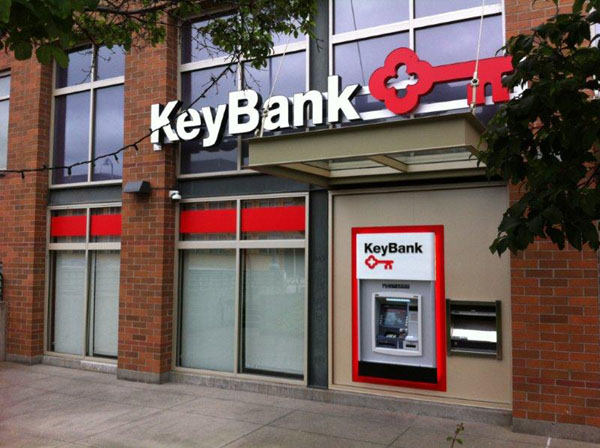
The design and treatment of the lower floors of buildings have a decisive influence on the life of an urban space. This is something we feel intuitively as we walk along a well-designed block with a variety of uses and plenty of visual interest. To paraphrase the preeminent urban designer Jan Ghel, building frontages are the city’s edge zones that you see closely and experience intensely and where buildings meet and mix with the city. If the ground floors of buildings are designed in porous, transparent and interesting ways, the simple experience of walking down a city street can be energizing.
Accordingly, there are strong reasons for city policy to promote active and interesting ground floors, particularly in our neighborhood centers. Seattle recognizes this in its Design Review Program, which reviews the architecture and design of new developments throughout the city. One of the key Design Review guidelines is the pedestrian environment, which states that “buildings should avoid large blank walls facing the street, especially near sidewalks.â€
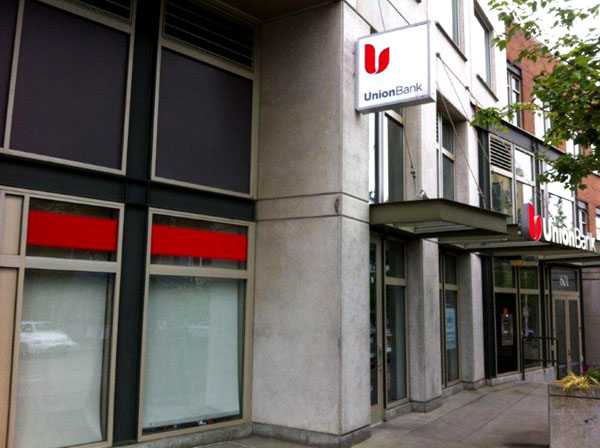
Though this objective is often met in the development and construction of new buildings, in the actual operation and tenanting of buildings it is occasionally severely lacking. This is no more evident than in the recent wave of bank branch openings in Seattle’s neighborhood centers, many of which are deliberately designed to have large blank facades that make for an unattractive and uninteresting streetscape. I’ve come to think of these new spaces as b(l)anks.
A b(l)ank is a bank branch in a prominent location that is deliberately designed and operated to function more as a billboard than a part of the commercial community of the neighborhood, with large ATM walls and street facing windows obscured by blinds or ads. A prime example of this is at the corner of Fremont Avenue and 34th Street in the heart of the city’s iconic Fremont, where three bank branches now define what should be a lively and interesting intersection.

Given how much time and effort goes into designing, reviewing and constructing buildings to promote transparent and interesting storefronts, it is unfortunate that poor tenant selection can negate much of the benefit of good design and end up being detrimental to the streetscape and consequently the care and commitment people have to their shared space. Having banks in our urban centers is of course quite useful, and building owners are obviously attracted to the income and credit that come with bank tenants. But one can only hope that many building owners and banks will begin to recognize that in an era in which walkable urbanity is increasingly prized, tenanting buildings with uninteresting uses that deliberately create blank facades and turn their backs on the street may be bad business in the long run.
>>>
Gabriel Grant is Vice President at HAL Real Estate Investments and is currently an Affiliate Fellow of the UW’s Runstad Center for Real Estate. All photos by the author.
Top Five Reasons I’m Voting for Michael McGinn for Mayor
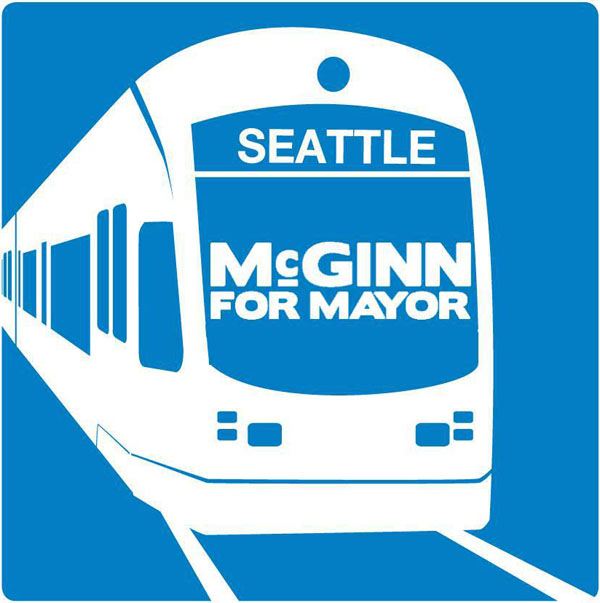
#5. Â We shop at the same place for clothes.
When I ran into the Mayor at City Hall on the way to sit in on a PLUS committee meeting there, we were both locking up our bicycles and talking about riding in street clothes, and it came out he’d bought his suit at the same place I’d gotten my wool pants — Goodwill. I like a government official who is as thrifty in his personal life as he is in office. McGinn, working collaboratively with Council, has balanced the City’s budget and restored the City’s “rainy day fund.”
#4. He can admit where there is room for improvement.
At the going-away party for a Cascade Bicycle Club employee, a friend asked me about my post here on Citytank, “How Seattle Thwarts Innovative Building“. The Mayor overheard, stepped over and said, “Let me summarize: We suck!” That opened a great conversation on the subject of the Living Building Deep Green Pilot Program in which the Mayor allowed that I was right, that there could be better ways to get more ultra-low energy buildings built in Seattle, and that we seriously needed to make that happen. Humility is an admirable quality in anyone, but especially impressive in an elected official.
#3. Â Mike is the best candidate.
Here is my take on the others:
Ed Murray: I can’t tell what Ed Murray believes in. Though his message is all “I’ll be collaborative and get things done,” his campaign has been mean and divisive, and from what I can tell about what’s coming out of Olympia these days, he’s not getting a whole lot of done down there. Sorry, not buyin’ it. The fact he’s gay doesn’t mean he should be mayor any more than it means he shouldn’t, though I admit that was a point in his favor for me before I checked out his campaign website and found, well, no vision. I’m more than a bit concerned about his Big Coal and Big Oil major backers.
Peter Steinbrueck: I like Peter a lot. He’s super intelligent and he’s an ARCHITECT, for Pete’s sake. (And an urban planner!) Several friends whose judgment I respect are backing Peter. I do think he’s been painted a little too swiftly and broadly with the NIMBY brush by writers looking to pigeonhole the various candidates for easy reader consumption. That said: Seattle absolutely needs intelligent urban planners…doing urban planning! The skill set for running a city is a different one, I think, than what I’ve seen expressed in his campaign so far, which has been at times stumbling and amateurish. (Going after the dog-owner constituency? Seriously?) An urban planner absolutely ought to have exactly the kind of nuanced views that Peter has. More importantly and unfortunately though, Peter has come down on the wrong side of a couple of issues that are big deals for me. The idea that retaining views of the Space Needle ought to be considered in zoning seems off the wall. And then there’s his endorsement by John Fox of the Seattle Displacement Coalition. The views that Peter would have to have to get Fox’s endorsement are deal-breakers. I was there at the Mt. Baker Community Council meeting where Fox cronies handed out pictures of the slums of Mumbai to illustrate what would happen if the area was rezoned to allow higher density. Peter did–and would again–make a fantastic City Council member. I will get behind him 100% if he ever runs for that office.
Bruce Harrell: I met Bruce when he came to speak just after I did at the Cascadia Green Building Council’s Come Rain/Shine event, a day-long charrette on getting to net-zero water in development and in buildings. He came late, looked kinda bored, said his bit, and left. He seems like a nice guy, but I was not impressed with his commitment to my issues. I don’t know why he’s running.
Joey Gray: I really like Joey. She’s earnest, and principled, and committed to working hard on what I think are exactly THE super-important issues. I wish she was running for Council instead of Mayor. If she was I’d vote for her in a heartbeat.
I listened to the others at AIA Seattle’s Mayoral Forum, and have read about their positions in various articles, but I don’t think Kate Martin, Mary Martin, Charlie Staadecker or Doug McQuaid are particularly contenders in this race.
#2. Â As a bicycle commuter and ardent advocate for everyday bicycle riding, how could I NOT vote for a candidate nicknamed “Mayor McSchwinn”?
I’ve been car-free for more of my adult life than I’ve not been; I share my office with Cascade Bicycle Club; I ride to work every day; I want my son and his friends to be able to ride on the street safely; I want to live in a city where there are other ways of getting around besides the automobile. Michael McGinn has advanced this cause consistently and well over the last four years, as evidenced by his endorsements from Cascade Bicycle Club, Seattle Bike Blog, and Seattle Transit Blog among others, and I want more of this. (Faster, of course.)
#1. Mike McGinn has put addressing climate change at the forefront of his policies.
This is the central issue of our time. If we act decisively on climate change now, Seattle can lead and export innovative solutions to the rest of the US. If we don’t act now we’ll be playing catch-up, and all of the other issues we’re talking about now in this race will fade into the background as our financial and intellectual resources become increasingly dedicated to adaptation and mitigation of the effects of climate disruption.
McGinn spoke eloquently about climate change at the fundraiser I co-sponsored with Alan Durning of Sightline Institute, Brice Maryman of SvR Design, and Chuck Wolfe, author of Urbanism Without Effort, (paraphrasing): “We are the last generation who can do something about climate change. In 20 years, when my kids ask me what I did about it, do you think I’ll want to say ‘I got along with other politicians’?”
I first met Mike McGinn at the Carbon Neutral Unconference at Mithun, (organized by Alex Steffen and Justus Stewart) not long after he was elected. (Councilmembers Richard Conlin and Mike O’Brien were there too!) The Mayor has been at the leading edge of so many initiatives in the realm of climate change: the Carbon Neutral Seattle study that followed that initial day’s work; developing the Carbon Neutral Action Plan; divesting Seattle from fossil fuel holdings; light rail expansion; road diets; bicycle infrastructure improvement; fighting against the Deep Bore Tunnel. (Which I personally think is certainly showing signs of being a A Very Big No Good Terrible Bad Ideaâ„¢ — how about those eight lanes of traffic on the waterfront?)
Mike McGinn is a man with principles. He is not a politician, and as such he has taken a lot of flak about that from, well, mostly politicians. McGinn’s principles are my principles, and I deeply believe that those principles ARE worth fighting for, that we must act NOW or pay a price in human suffering later that we cannot bear.
I have learned something about endorsements hanging out with my friends at Cascade Bicycle Club. They base their endorsements solely on how the candidates stand on issues that will affect members of the club. My “club†is climate change. Climate Change has been the central issue of my work in architecture for 20+ years. It continues to be the lens through which I view candidates for office. In those terms, no one else is running for Mayor. I heartily and unequivocally endorse Mike McGinn.
>>>
Rob Harrison, AIA, is a Seattle architect and Certified Passive House™ Consultant.
Opposite Ends of I-90: The Role of the State
The State of Washington’s Growth Management Act is an important local and regional planning tool, but beyond that, the State plays a minimal role in promoting smart growth. Over in Massachusetts, State lawmakers recently proposed legislation that provides good examples of how Washington State could do more. The Boston Globe editorial board frames the issues well:*
Tidy downtown Winchester, just 20 minutes by train from North Station, should be a prime target for new development. According to one recent study, Greater Boston may need 19,000 new housing units every year just to keep pace with demand. And Winchester would welcome new residents: Town Manager Richard Howard says downtown restaurants and stores are eager to see new residential development on the city-owned lots, and that a planned upgrade to the commuter rail station next year could bring new vitality to downtown. The style of transit-oriented housing would also fall in line with the state’s environmental goals, which call for concentrating residential and commercial development near rail stations.
The obstacle, though, is the state’s dysfunctional ’70s-era zoning code, which sets the parameters for how individual cities and towns plan for development — and, in practice, sets up complex permitting rules and creates numerous opportunities for litigation. The process of securing approval to build new housing in downtown Winchester is so onerous, Howard says, that developers simply won’t bother…
What it amounts to is the worst of all worlds. Sensible, smart-growth housing plans often languish, while single-family homes proliferate on large lots in sprawling suburban subdivisions — one of the few types of housing that can be easily built in Massachusetts under current law. State officials rightly fear that the housing market dynamics squeeze middle-class families so much that they’re endangering the state’s economic health. It also ensures that much of the growth that does occur is unplanned, expensive, and environmentally harmful.
It’s pretty much the same story in greater Seattle, except that it’s more local rather than State regulations that are getting in the way. Another difference is that numerous rail systems are already in place across greater Boston, while much of the planning for growth around transit in the central Puget Sound region is for future stations. In any case, effective planning at the regional scale requires a regional authority that has both big “sticks†and big “carrots,†and that typically means the State. The State legislation proposed in Massachusetts would:
…offer municipalities a raft of enticements to align their zoning policies with the state’s housing needs. Communities that opt to designate a dense-growth zone would get access to state planning money and a leg up in competition for billions of dollars in state sewer and water aid. Crucially, the bill would also allow towns with dense-growth zones to assess extra impact fees on developers to account for the burden new residents create for schools and libraries; easing the common worry that new residents will burden public services should make towns more receptive to new housing. The bill also gives towns that accept dense development zones more authority to prevent construction in other areas. That will deter sprawl-style development, and locals who fear the impact of new construction on open space will have an incentive to support dense-growth zones in their towns.
It would also give towns new authority to limit subdivisions, encourage municipalities to simplify their permitting processes to make approval more predictable, and expand an existing program that awards cash to towns and cities that designate neighborhoods for dense, mixed-income housing.
“Top-down planning” is a dirty word to many who follow urban planning issues—the 2009 Washington State House Bill 1490 (the “TOD bill”) is a notorious recent example of overblown concerns. But the reality is that regional land use planning cannot succeed without programs that apply to the region as a whole. And the most powerful strategy is funding—i.e. a carrot—offered to municipalities that align local planning with established regional policies, as do many of the Massachusetts proposals noted above.
Though more likely to be contentious, the State “stick” should also play a role. Since 1969 Massachusetts has had one of the more extreme examples of that stick applied to affordable housing in its Comprehensive Permit Act, a.k.a. “40B.†40B allows developers to circumvent local zoning if they are proposing to build affordable housing in a municipality that has a shortage. 40B is far from perfect, and it seems highly unlikely that such a law could be passed in Washington State today, or pretty much anywhere else in America for that matter. But if we’re serious about tackling our region’s housing challenges, we ought to be considering bold, State-level strategies along the same lines as 40B.
As an example of how the State’s carrots and sticks could be applied, consider the widely agreed upon goal in the central Puget Sound region to ensure sufficient affordable housing in locations with access to high-quality transit. Today there are few effective tools to make this happen. What if State funds were made available to subsidize housing in transit station areas, but only for municipalities that zone their station areas to accommodate significant growth? Or how about 40B-style law that applies only to the construction of new affordable housing located within a station area? (One of the flaws of 40B is that it doesn’t regulate where within a given city the affordable housing can be located.)
With its Growth Management Act, Washington State has pushed further than most States to promote smart growth. But local, regional, and global conditions have changed massively in the 22 years since it was enacted. The State—and the central Puget Sound region in particular—is growing up. It’s time for the State and its municipalities to play nice together like grown ups for the good of us all.
>>>
This post is part of a (sporadic) series. Photo by the author.
*Must be nice to have a newspaper with an editorial board that isn’t stuck in the Leave It To Beaver era.
Opposite Ends of I-90: Mayors’ Priorities
Boston or Seattle?
…a bright-eyed focus on micro-units and bike sharing and restaurant-driven redevelopment might seem overly idealistic — a distraction from the realities of many neighborhoods.
Boston has an upcoming mayoral election, and the above quote is taken from a Boston Globe editorial on what the next mayor should focus on. The main issues called out in the piece have so many parallels with Seattle it’s worth excerpting a big chunk of it here:
Working through parking anxieties. When Boston was hemorrhaging residents to its suburbs, the city bent over backwards to provide something suburbanites take for granted: free, convenient parking. In addition to launching resident-only sticker programs for street parking in neighborhoods, the city also required developers of new housing to build spaces for cars. Yet minimum-parking rules push up housing costs significantly and squeeze out other amenities, such as outdoor space or extra storage, that tenants might value more. The rules also send an odd message: that Boston won’t accept newcomers if they make it harder for current residents to park for free.These rules are being overtaken by events. Once-utopian ideas like car- and bike-sharing have become part of the local transportation system. Even as the population grows, the number of vehicles being registered in the city keeps falling. Recognizing all this, the Boston Redevelopment Authority has wisely eased up on parking requirements. Will the next mayor go further, or reverse course amid criticism from some neighborhood groups?
Using the market to make housing affordable. In theory, minimum-square-footage rules keep unscrupulous landlords from keeping tenants in Dickensian squalor. In practice, fears that smaller apartments will turn into flophouses aren’t warranted, especially in a city where soaring housing costs pose a far greater danger than urban blight. Allowing smaller units onto the market cuts costs by squeezing more units into the same pricey lots.
Reinventing civic life. In the 1960s, when urban planning meant bulldozing some parts of town and blasting highways through others, Boston’s historic neighborhoods had much to fear from grand schemes from on high. The city learned from that, and now gives neighbors and neighborhood associations a strong voice in decisions that might affect them.
But fending off ill-conceived planning schemes is only a small part of what keeps a neighborhood vital; filling it with a varied mix of people, businesses, buildings, and attractions is the bigger part. Yet in discussions of business licenses, proposals for new housing, and other ideas, neighbors often wield their veto reflexively, and it’s easier for authorities to say no to unusual proposals than to say yes. Weekday Licensing Board meetings or early-evening planning meetings don’t draw in the full range of public opinion; would-be mayors should seek out additional ways — from online forums to social media — to gather input from a broader range of Bostonians.
Encouraging late-night business. Even before all the recent attention on tech workers with 24-hour schedules, people in many long-established occupations — late-shift cops, medical residents, emergency-room nurses — needed places to eat, shop, and work out after the city rolls up its sidewalks at night.
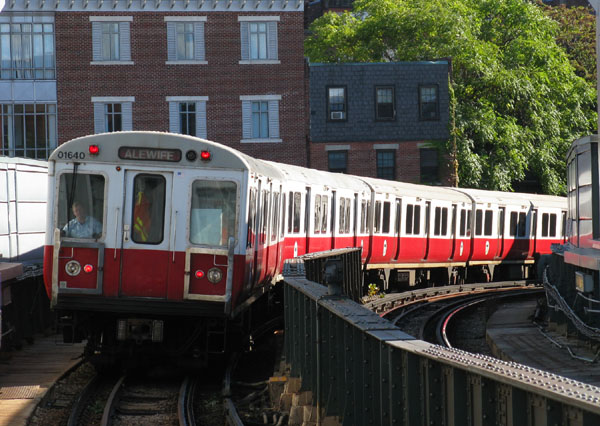
From the perspective of Seattle, two key urban planning issues missing from the above discussion are transit and density, and that’s because Boston is out ahead in both of those departments. In addition to a robust bus system, Boston has an extensive subway, as well as numerous commuter train lines. Boston has almost twice the population density as Seattle, and that not only supports a wonderful walking city, but also makes Boston’s transit systems inherently more viable than Seattle’s.
While it’s important for the future mayors of both Boston and Seattle to take on the objectives quoted above, Seattle’s mayor will have the additional burden of addressing the critical need to expand transit and raise density. For those who believe Boston is a good model for a city, these two core issues should be the primary lenses through which to evaluate Seattle’s candidates.
>>>
This post is part of a (sporadic) series.
Opposite Ends of I-90: More (Bicycle) Parking Please

“I got rid of my car because I was tired of parking,†the Southie resident said, “and now I have a new kind of problem.â€
Maybe some day people in cities like Seattle and Boston will get as incensed about a lack of parking for bicycles as they do today about a shortage of parking for cars. That “some day” would indicate major progress toward sustainable urbanism, but it’s still a long way off—no doubt the above front page story in the Boston Globe isn’t generating much sympathy from the average reader.
As a daily bike rider in Seattle for the better part of two decades, the lack of a convenient place to lock my bike has been an occasional minor annoyance, never a major issue. If enough people start riding bikes in Seattle that could change, but I would file that scenario under a good problem to have. A parking shortage problem is a lot easier to solve for bikes than for cars.
As demand for bike parking increases, one solution I would hope to see more of is on-street car parking spaces converted to bike parking, as the City of Seattle has done in a handful of locations. As Sightline’s Alan Durning recently pointed out, it’s perversely unfair that space in the publicly owned right-of-way can only legally be used to store cars.
The Boston bike stats quoted in the Globe article are impressive: from less than a mile to 65 miles of bike lanes in six years. As more and more cities throughout the nation have begun to recognize how investments in bicycle infrastructure can promote economic development, even unlikely cities are getting in on the action, such as Lincoln, Nebraska, where a grade separated bike lane is in the works.
Meanwhile back in Seattle, the private developers are also starting to respond to increasing interest in bikes. As an indicator of future trends, the new Via6 apartments in Seattle have a bike shop at the street level, and biking is a big part of the lifestyle that’s being marketed to potential renters.
If cities hope to stay ahead of the urban biking wave, they’ll have to make ongoing investments in all components of bike infrastructure, including bike parking. And that, as is so often the case for proposed change that challenges the status quo, will come down to electeds having the political backbone to say no the naysayers.
>>>
This post is part of a (sporadic) series.
Opposite Ends of I-90: Same Old Same Old Parking Story

In the world of contemporary urban planning nothing is more universal than battles over parking. Travel 3,000 miles east from Seattle on I-90 and you’ll find familiar debates raging over how much parking should be built with new development.
You’ll also find a similar pro-car bias:
 [Boston officials] are deliberately discouraging construction of new spaces.
No! They are only relaxing regulations that require developers to build parking. Nothing is being proposed to actually penalize developers for building parking if they want to.
Not until after the issue has been framed as heavy-handed social engineering does the second paragraph explain all the important reasons why a City might not want to mandate the construction of too much parking:
The goal is to encourage the use of public transportation, and to devote more land and money to affordable housing, open spaces, and other amenities. Officials also say the city’s youthful population is becoming more accustomed to life without a car.
Yes! Though they might have added that cars are also one of the largest sources of greenhouse gas emissions.
The Globe article also provides the obligatory claim by a resident that “the reality is that people here are going to have cars…,” contradicting the demographic trends cited in the article itself. Similarly, in an apparent effort to pander to that misinformed, selfish concern, Seattle mayoral candidate Peter Steinbrueck said at a recent forum that “many of us still have to drive … and I don’t think the City should be in denial about that.”
In a City where the vast majority of public transportation dollars are still spent on car infrastructure, such a claim is laughable, not to mention a straw man insult to those who hope to rebalance a dysfunctional transportation system that has been manipulated to favor cars for half a century.
The people truly in denial are those who don’t understand the importance of transforming our cities away from car dependence, and who cannot recognize that excess parking is one of today’s biggest barriers to sustainable urban development.
>>>
This post is part of a (sporadic) series.
Tipping Points for Ideological Urbanists
There are going to be tipping points: thresholds where we decide that the rutted road we’ve been traveling has, inadvertently, led us astray. Last week certainly saw some cultural tipping points. But recent readings on two fronts in the built environment have us thinking that interesting new constituencies are coalescing around some interesting themes that will reset past assumptions to strategically position us for the future.
More Constrained Ex-Urban Growth
The limitless sprawl of various American urban areas into surrounding farms and resource lands has long been derided for its impacts to the environment (deforestation, species loss, polluted waterways, etc), but more recently, fiscal conservatives like Charles Marohn of Strong Towns have been giving the financial model supporting this type of growth pattern a serious, well-argued drubbing. This week, Charles began digging deeper with a series called Dumb Money. It is wonky, but fantastic.
The hard-nosed fiscal analysis by Strong Towns, based in the heartland, resonates well with the coastal capitalists who read Fast Company. Covering a new report from Smart Growth America, FC reports that the smart growth model, by concentrating growth and capital, has a higher return on investment and offers better economic resilience.
It finds, on average, that smart growth costs 38% less in upfront infrastructure (roads, water, sewers, libraries, and so on). For example, Champaign, Illinois, concluded that smart growth could save $52 million, or 42%, over 20 years.
Then, the report looks at the relative cost of services like fire, police, and ambulances. It finds a 10% saving, on average. Charlotte, North Carolina, for example, worked out that a “smart growth neighborhood†would cost a quarter of a conventional one.
Accelerating this more constrained growth condition may be the loss of one of the economic drivers for the sprawling suburban housing market: the mortgage interest tax deduction, or, as Streetsblog recently called it, The Granddaddy of Sprawl Subsidies. In recent budget negotiations in Washington, repealing this deduction has found resonance across party lines, so we may soon be seeing it disappear from our tax forms.
![[ The white pinpoints (cities) are where the federal mortgage interest deduction is helping people the least. However, the feds are helping the suburbs sprawl. Image: Pew Center on the States ]](http://citytank.org/images/Pew_Center_map_mortgage_interest_deduction.jpg)
The white pinpoints (cities) are where the federal mortgage interest deduction is helping people the least. However, the feds are helping the suburbs sprawl. Image: Pew Center on the States.
The opposite ideological flip is happening amongst progressive environmental urbanists. Influenced by more libertarian-leaning writers like Edward Glaeser, writers like Slate’s Matt Yglesias and Sightline Institute’s Alan Durning have recently been calling for “less-regulated urbanism†that would “allow taller buildings, which would accommodate dramatically more people, office space, and shops in the most efficient and desirable locations: close to city centers.â€
Sightline’s most recent exploration of how excessive(?) regulations create less-desirable built environments focuses on parking. First, Alan unpacks the perverse parking economics along his Seattle single-family street:
The net effect—one mandatory off-street parking space plus one car-less household—is a one-space reduction of parking supply on my block. Repeat: my obligatory driveway and garage deprive the universe of one on-street slot. This is ironic, but it’s only the tip of the irony iceberg where car-storage is concerned.
If I did own a car to keep in my garage, the net effect would no longer be a net reduction. It would be zero. My driveway subtracts one on-street space; my garage adds it back. Think about that for a while. The 4.6 million single-family houses in cities across the Northwest, and tens of millions more elsewhere, are each required to have at least one off-street parking space. Yet many of these city rules add no net parking spaces to their cities’ supplies. Worse, if you’ve ever narrowly escaped a car backing out of a garage, or almost backed into someone while you were driving, you can quickly grasp the fact that all these millions of mandated off-street parking spaces turn sidewalks into danger zones, especially for children and the disabled.
Then Sightline contributor Alyse Nelson provides a wide-ranging photo essay, entitled Ugly by Law, about the aesthetic impacts of parking lots on the built landscape. Warning: you can’t un-see some of these things.
>>>
Brice Maryman is an ideological urbanist landscape architect with SvR Design.
Photo of Seattle’s Capitol Hill neighborhood celebrating the passage of the Washington State gay marriage bill, Nov. 6, 2012, by Dan Bertolet.
Â
How Seattle Thwarts Innovative Building
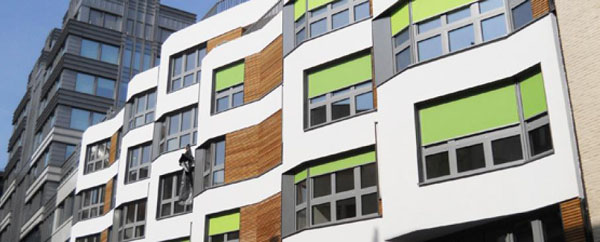
Seattle prides itself on its forward green thinking. However, it lags terribly behind on forward green doing. Why is that? There may be other factors endemic to the banking system in the USÂ and the financing of projects, but here are two Seattle-specific issues:
- The City’s most valuable incentive to developers of deep green buildings, the additional height bonus, is at odds with the wishes of many immediate neighbors of these buildings. Thus, each new deep green building is greeted with opposition, instead of excitement and encouragement.
- Because of this opposition, the City sets up barriers to the granting of these incentives instead of providing technical or financial assistance to design teams and developers to help them achieve their deep green goals and grant them the incentives.
Those barriers add time and cost to projects that are pushing the envelope, making it less likely that design teams and owners will pursue the construction of innovative buildings.
City of Seattle rightly grants an incentive for something we desperately want and need, deep green buildings. However, in classic Seattle passive-aggressive style, while the incentive is saying “Yes, please go ahead and do this! We want you to do this!” the path to achieving that incentive is filled with pain and trouble. Why would the City choose to offer a height bonus instead of a financial award? Because height bonuses are free. It doesn’t cost the City anything to allow a developer to increase the height of their building. Once the building is built though, the increased property taxes from the larger building will help to pay for other needed city services.
Councilmember Nick Licata’s Resolution 31400 to establish a Sustainable Building Advisory Board illustrates my second point. On his blog, Licata writes:
In response to concerns raised over the Skanska project [Stone 34] by the surrounding community, the Bullitt Foundation, and Living Building Challenge representatives, I have introduced Resolution 31400. It calls on the City to provide updates and enhancements to its Living Building Challenge and Seattle Deep Green pilot programs. Resolution 31400 also requests the Department of Planning and Development (DPD) to form a standing Green Building Advisory Board to advise the City on sustainable building practices; to screen proposals for eligibility; and to assist in developing new or updated sustainable building programs.
In other words, according to Councilmember Licata’s expressed intentions, the Sustainable Building Advisory Board will be a watchdog group of green building professionals and community representatives charged with making sure no unworthy buildings are granted the height bonus, arousing the ire of neighbors. The Sustainable Building Advisory Board will be punitive in function rather than helpful and educational.
At the meeting of the Planning, Land Use and Sustainability Committee for Resolution 31400 on May 8th, Diane Sugimura, head of Seattle’s Department of Planning and Design (DPD) said that “a handful” of projects are “in the pipeline” that would be affected by the Resolution over the next two years–that is, three or four. Three or four buildings out of how many that will be built in the City of Seattle over the same period?
This is a program that is not working.
This is in stark contrast to Brussells, Belgium, where their extraordinarily successful Exemplary Buildings program has, since 2007, facilitated the construction of 117 ultra-low-energy green buildings–totalling nearly 3 million square feet. Over twenty-three buildings per year! Nearly half of those buildings are Passivhaus. There, winners of the three competitions held since the inception of the program have been given cash awards of $12 per square foot, technical assistance in achieving their goals, and their projects have been massively publicized. (Including a nice book.) Ninety per cent of the financial award goes to the owner of the building, and ten per cent goes to the design team. (See my previous blog post on the head of the Exemplary Buildings program Joke Dockx’s visit to Seattle for more.) For the Bullitt Center, the award would have been about $600,000.
As a result of the success of this program, the government of the Brussells region has mandated that as of January 1, 2015, Passivhaus will be required for all office, institutional and residential buildings, both single- and multi-family built in the 62-square-mile region. (Resolution 31400, like Seattle’s Climate Action Plan, makes no mention of Passivhaus.)
As of this writing in Seattle we have two Living Building Challenge Buildings (out a total of four in the entire United States) and one Seattle Deep Green building under construction. Seattle does have a fair number of LEED-certified buildings, but at 85% of current code, the energy-conserving bar is set very low for City-required-for City-projects-over-5,000-SF LEED Silver, and four out of five of those LEED Silver buildings will have to be renovated by 2050 if we are going to achieve carbon neutrality. (Yes, virtually all. Stockholm Environment Institute’s Carbon Neutral Plan for Seattle postulated that 80% of Seattle’s building stock would have to be renovated to something like Passivhaus standard– that is, to 10% of current code–by 2050.)
How can we encourage projects that meet that carbon neutral goal NOW; that do not have to be expensively renovated within the next 37 years? I suggest a new program similar to Brussells’ Exemplary Buildings program, combined with Passivhaus.
>>>
Rob Harrison, AIA, is a Seattle architect and Certified Passive Houseâ„¢ Consultant. This article originally appeared in the Harrison Architects blog.
Image credit:Â Brussels, Sustainable City
More Evidence: Increased Housing Supply Leads to Lower Prices
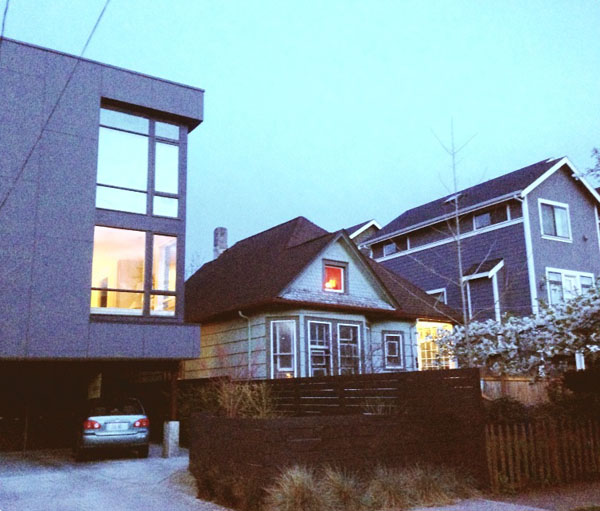
The idea that increasing housing supply—building more housing units of all kinds—has a beneficial impact on housing price is still very controversial in Seattle. Intuitively, people know that when there is more of something for sale, the price of it naturally begins to fall. Even so, there is a stubborn view here that making more housing doesn’t have the same effect on housing price. But the fact is, when developers make decisions about when, what, and where to build, the studies they use are based on an analysis of housing supply and demand, and how those factors affect price.
I’ve written elsewhere about academic studies that found reducing or holding supply constant in the face of increased demand definitely results in higher prices.
Still, there is no way to do a side-by-side controlled study of supply and demand on two comparable cities. One can’t take a city and impose limits on supply and hold demand constant while in an adjacent city turn up supply with the same level of demand over five years, then analyze the data. The world can’t always be a laboratory, nor does it want to be.
However, each and every day real estate decisions worth thousands and even millions of dollars are made based on forecasts about housing supply and demand. Where do developers turn when they try to figure out what to build? With lots of money at stake they aren’t likely to just wing it, and even if they wanted to gamble, risk-averse banks and investors wouldn’t let them.
Developers and real estate people use data in studies done by agencies that analyze supply and demand. One local firm, Kidder Matthews, just released a top-line analysis of the apartment market in Seattle. What does their forecast say about housing supply and demand?
Vacancy rates generally have an inverse relationship with changes in rent; as vacancy rates increase the rate of rent growth generally decreases. Over the past twelve months the average regional rent on a per square foot basis increased from $1.21 to $1.28/s.f./month (5.8% increase) in tandem with vacancy falling by 90 basis points.
The basic assumption advisers and decision makers in real estate share is that when it comes to housing (apartments in this case), excess supply—empty units—means lower price. It’s also what real, local, actual, retrospective data show.
What’s the future look like for Seattle and the region for apartments?
Rental rates have returned to historic highs and use of concessions is minimal in most markets. In response, new development has ramped up with an estimated 8,277 new units expected during 2013. Currently, there are more than 13,301 units under construction and a total of 21,989 targeting 2013 and 2014 delivery. Although vacancy has remained at very low levels for the past two years, accelerating future apartment deliveries should begin to put upward pressure on the market vacancy.
When price goes up the financial incentives to develop housing go up too. More people want the product, the price is higher, and new producers want to get a piece of that business. Vacancy rates drop, prices go up, more suppliers enter the market, competition ensues, prices fall, suppliers hold back, prices go up, repeat. That’s how the cycle works, at least for people who put real money into housing.
Market studies are used by developers, lenders, and investors as a map to decide what to build and where and when to build it. How housing supply and demand affects price is not an academic exercise for them—it’s their financial future. Real estate studies based on supply and demand are not dactylomancy; these studies are the most conservative time-tested measure used by the real estate industry to invest and build.
As the economy in Seattle improves more jobs will be created, and with those jobs comes increased demand for housing. Development of more housing—of all kinds—we will positively impact price. It will. Whether we should relax regulation, incentivize new development, and encourage a variety of housing types isn’t debatable anymore—it is a mandate, especially if Seattle intends to sustainably welcome growth and economic recovery.
>>>
Roger Valdez is the director of Smart Growth Seattle, where this post originally appeared.
No, this isn’t a minimum security prison, it’s the courtyard at Washington Middle School in Seattle’s Central Area. I asked my daughter if anyone ever goes out there and she said, “I don’t think we’re allowed to.” Sigh.
Dismal, neglected spaces like this send a message to our young people that we don’t care about the time they spend in school. And that’s just one particular instance of an overall lack of quality in the public schools that sends a message to parents that they should look to the burbs for something better.
The people who run diverse urban schools like Washington have a Herculean task just to keep things up and running, so this is no diss on them. But seriously folks, can’t we as a community do better than this?
>>>
Photo by the author. This post is part of a series.

